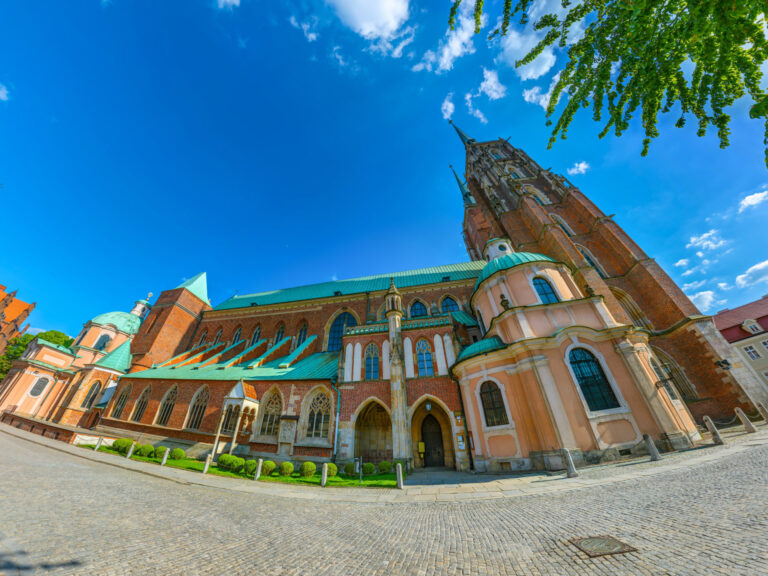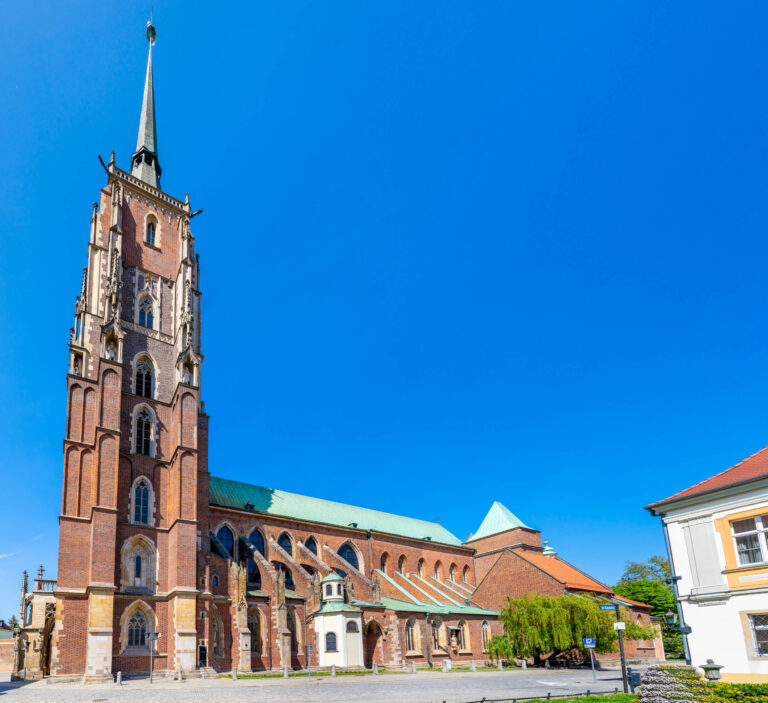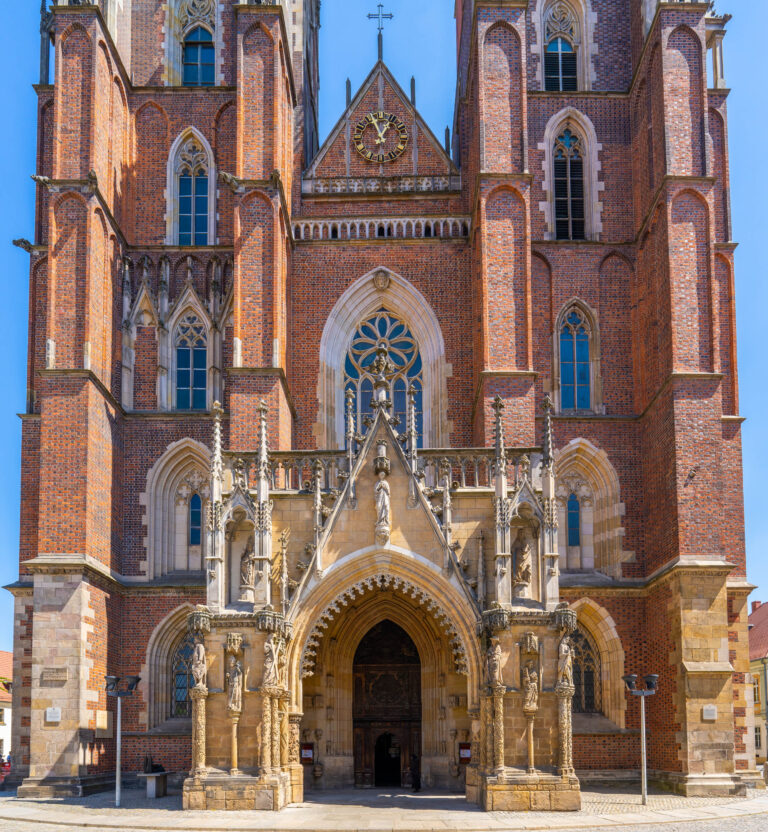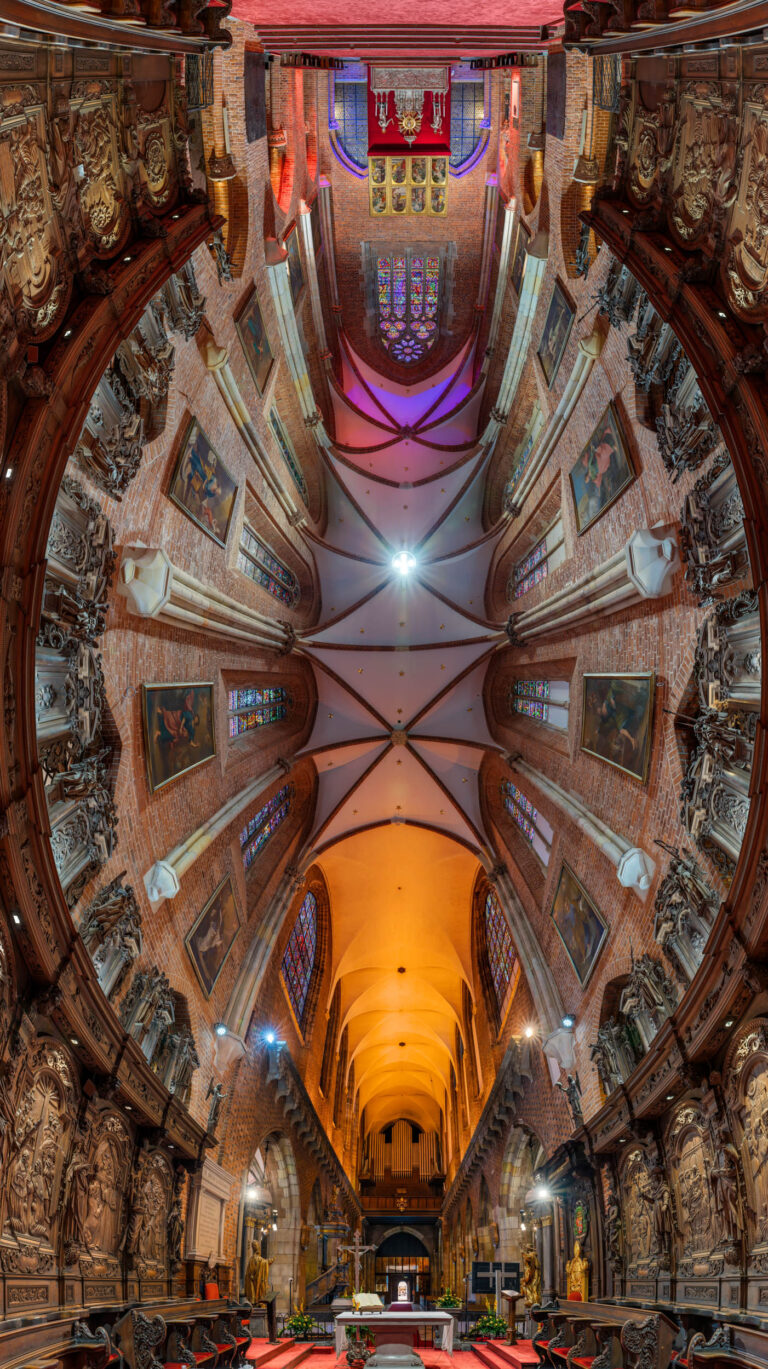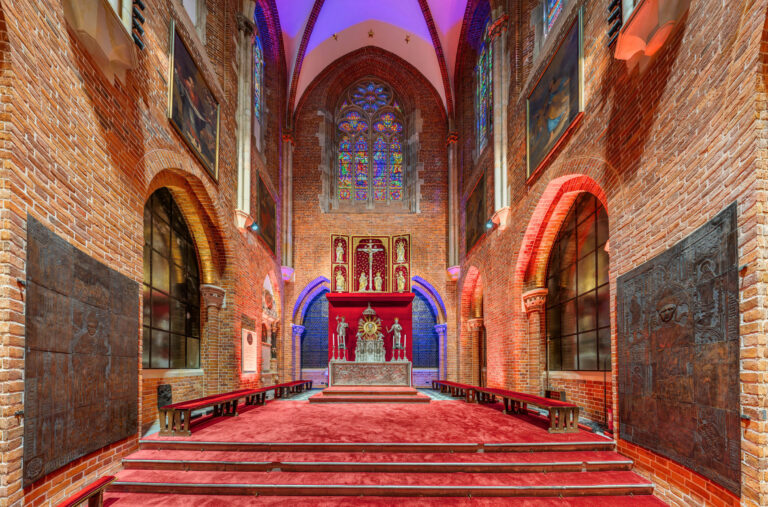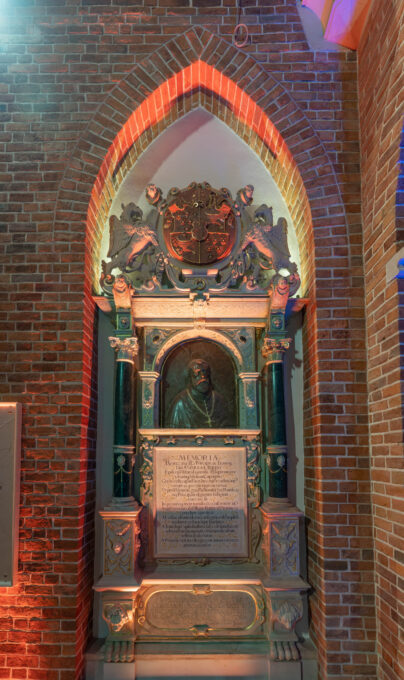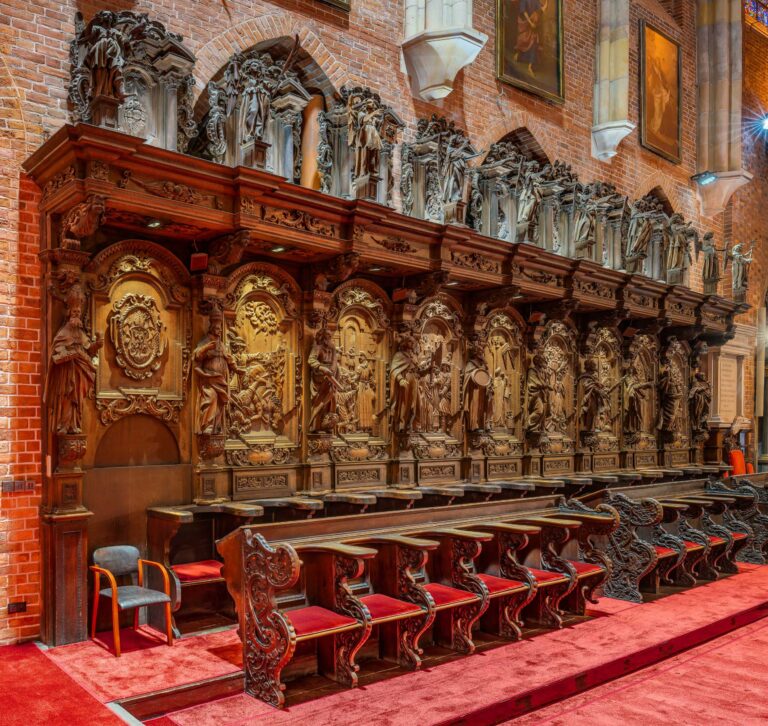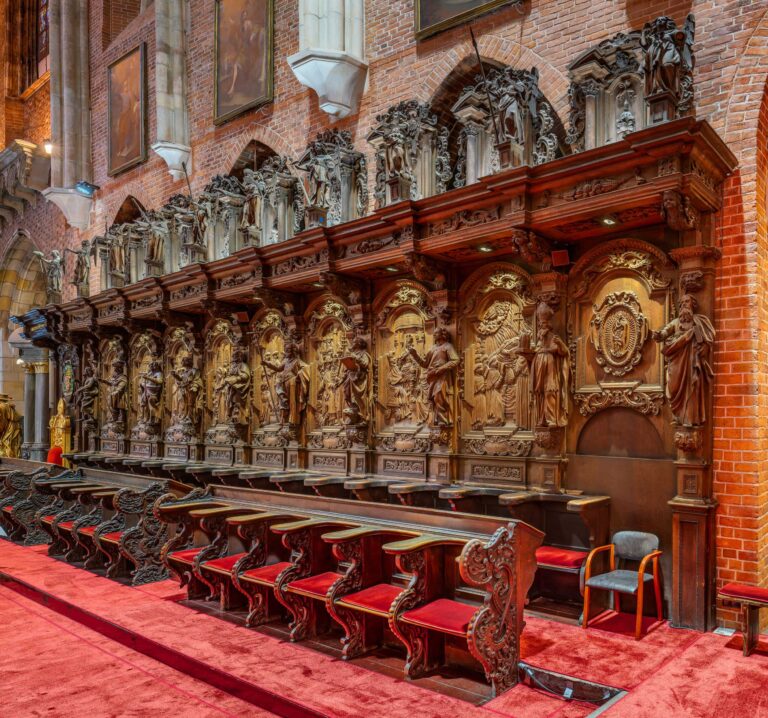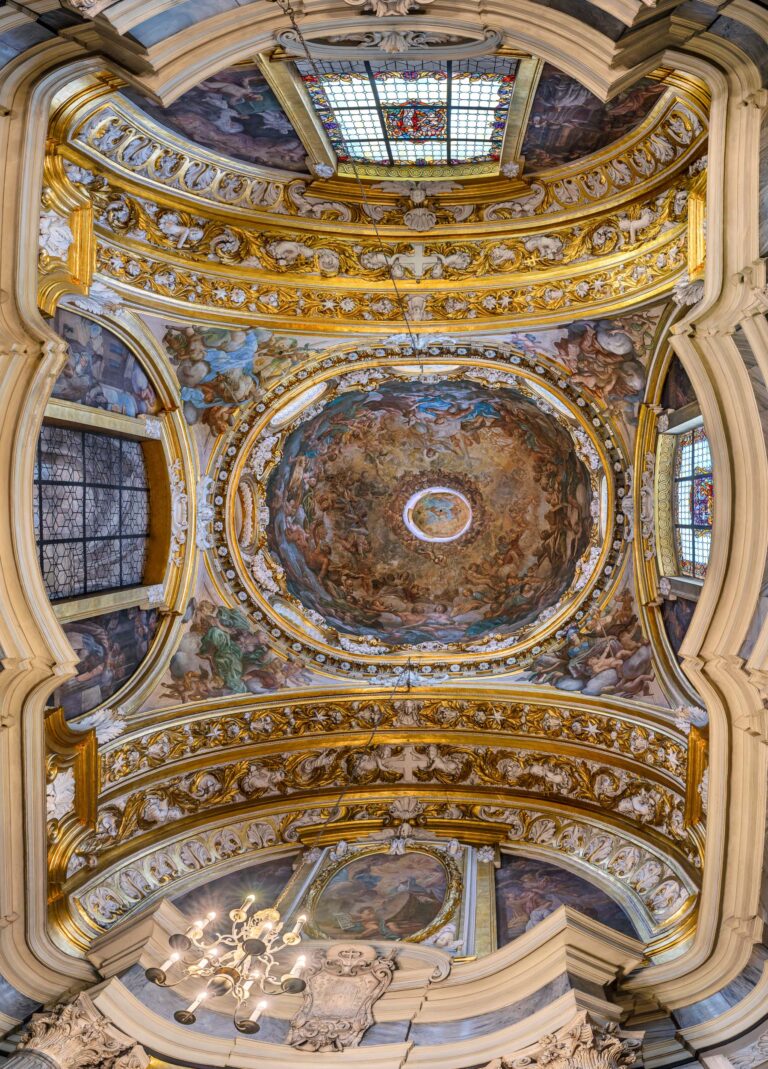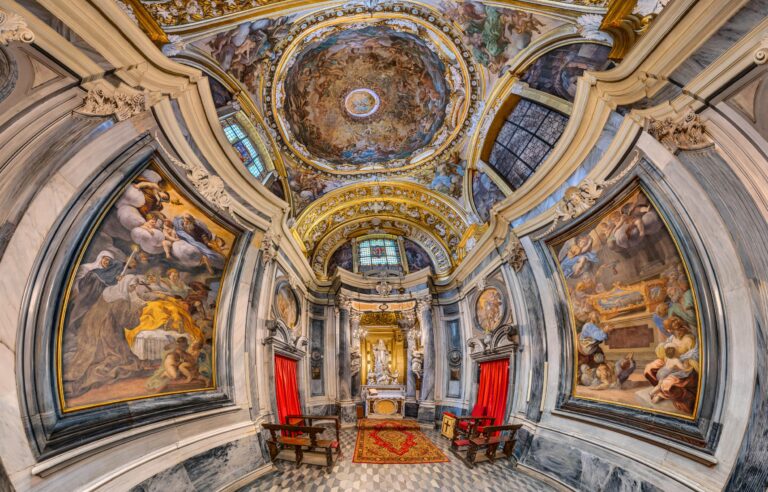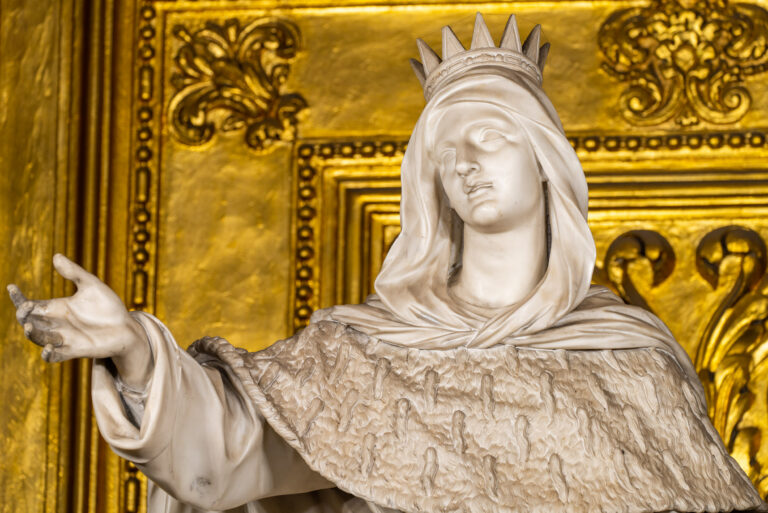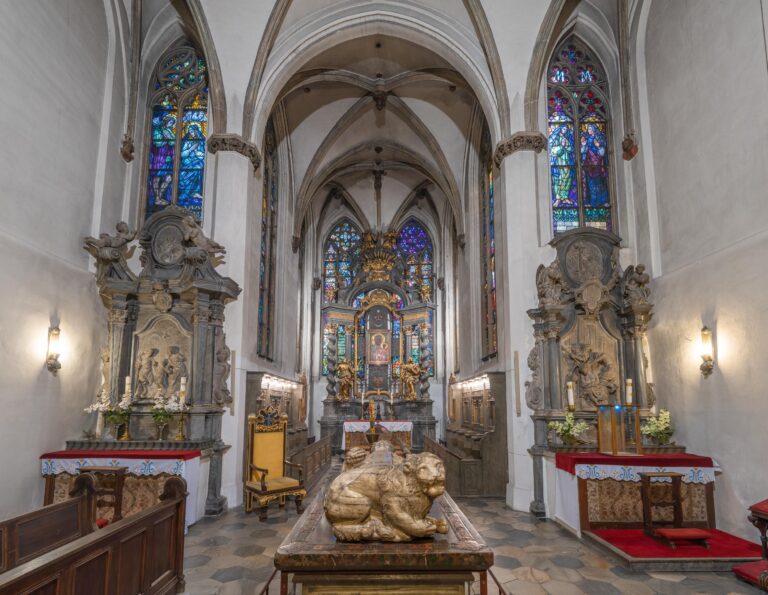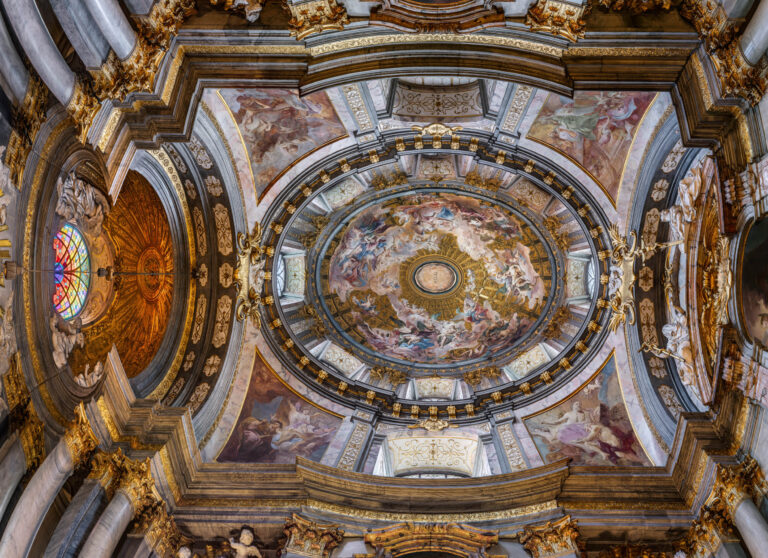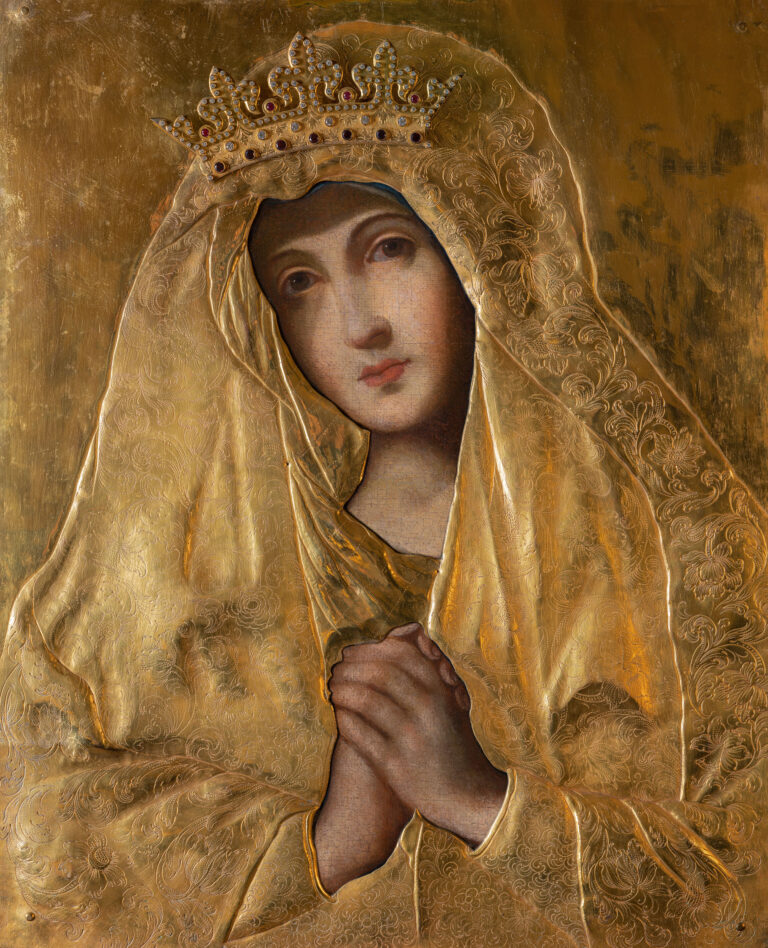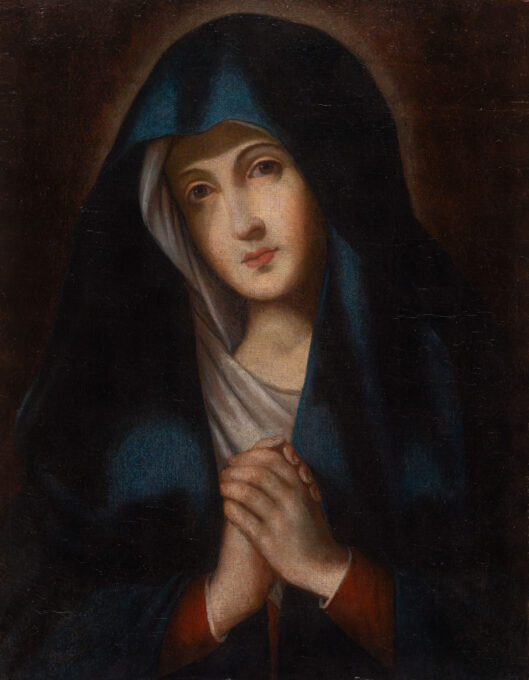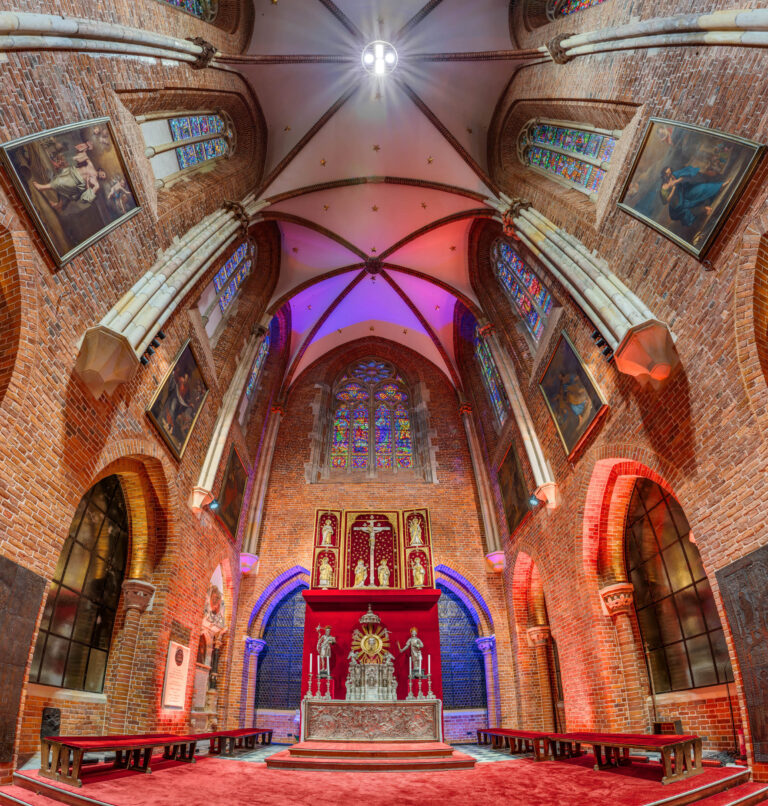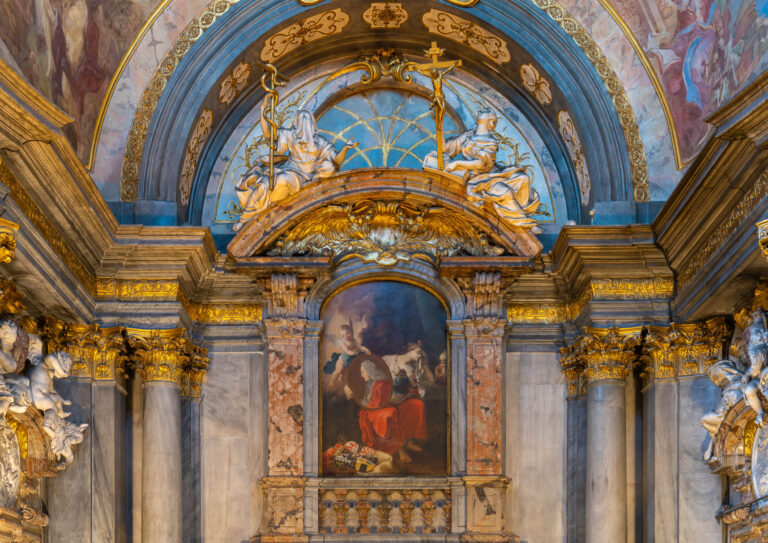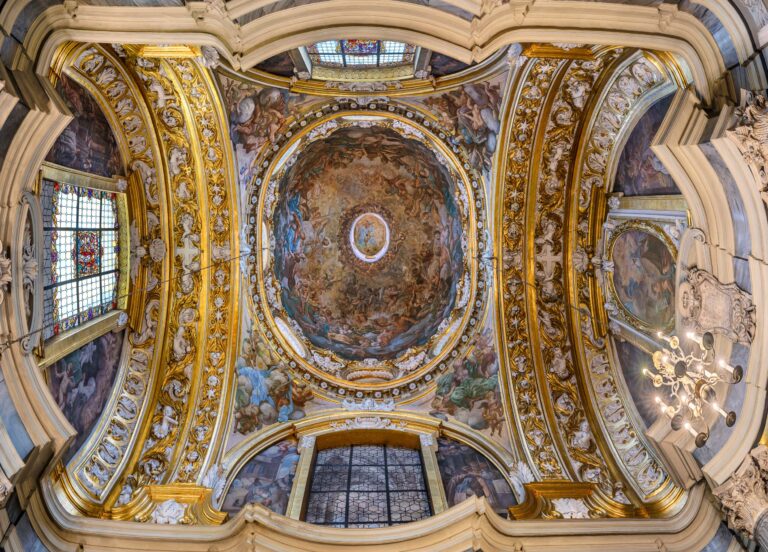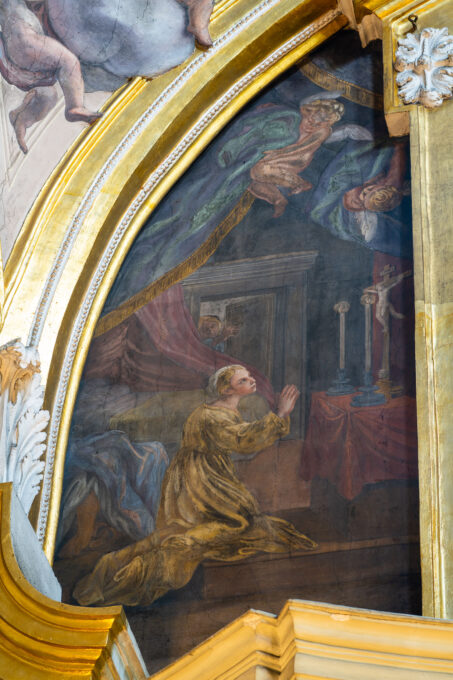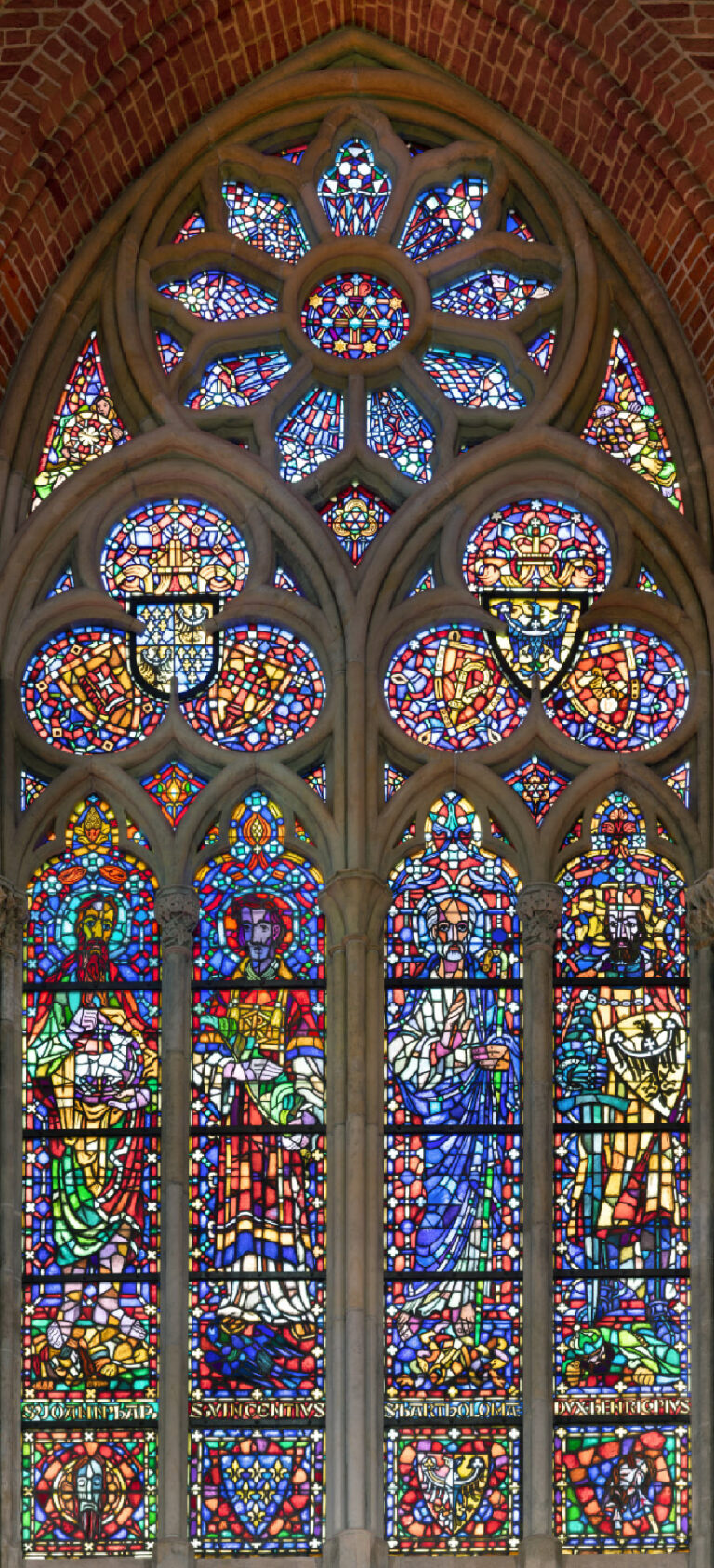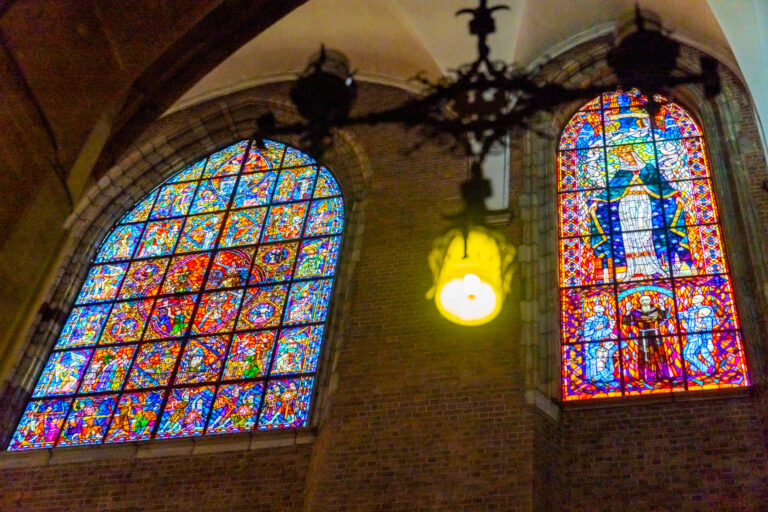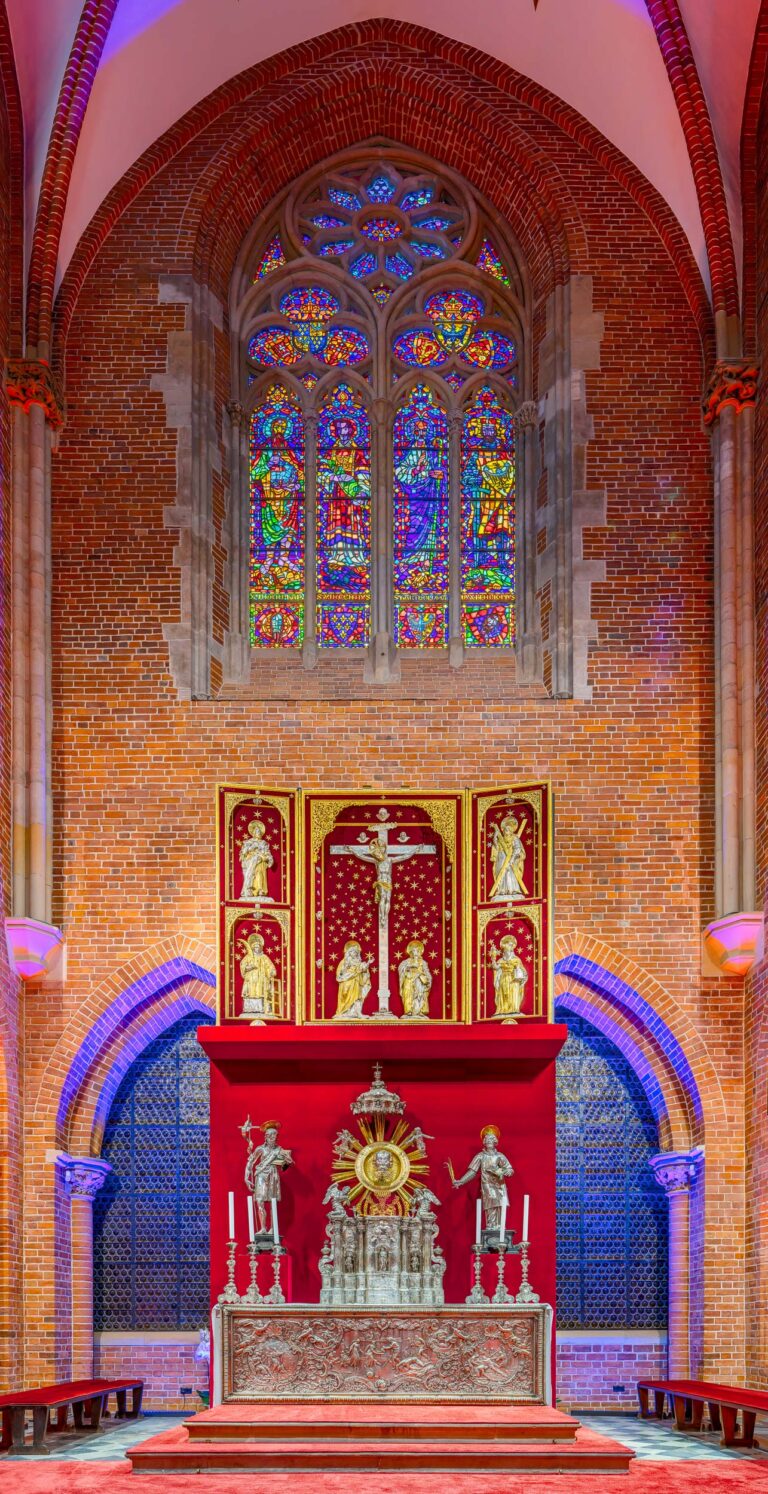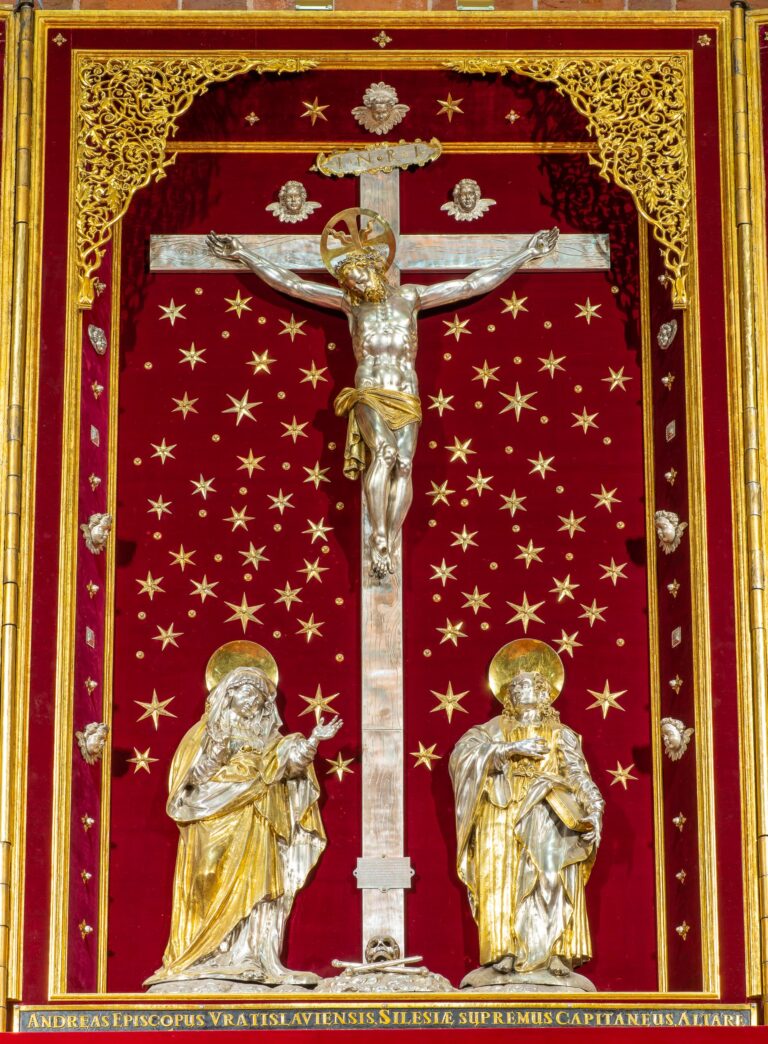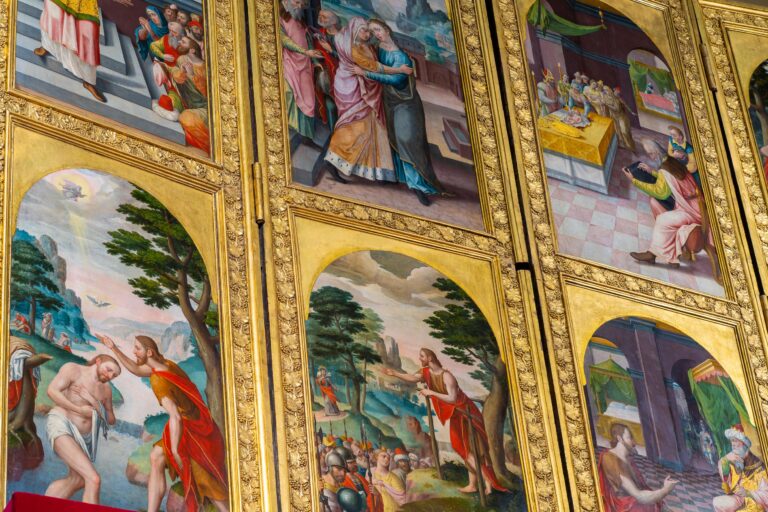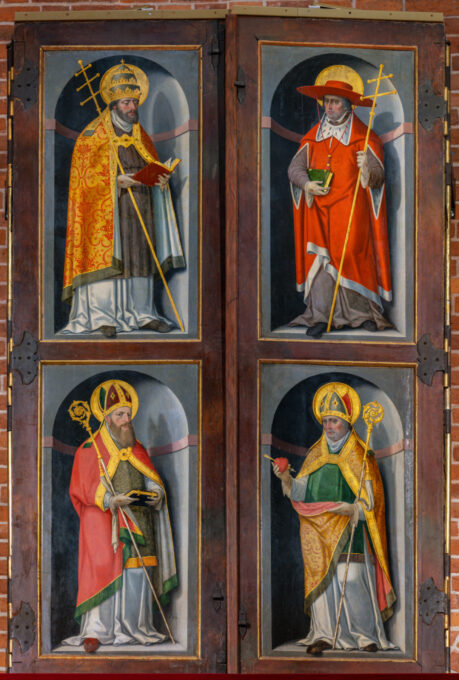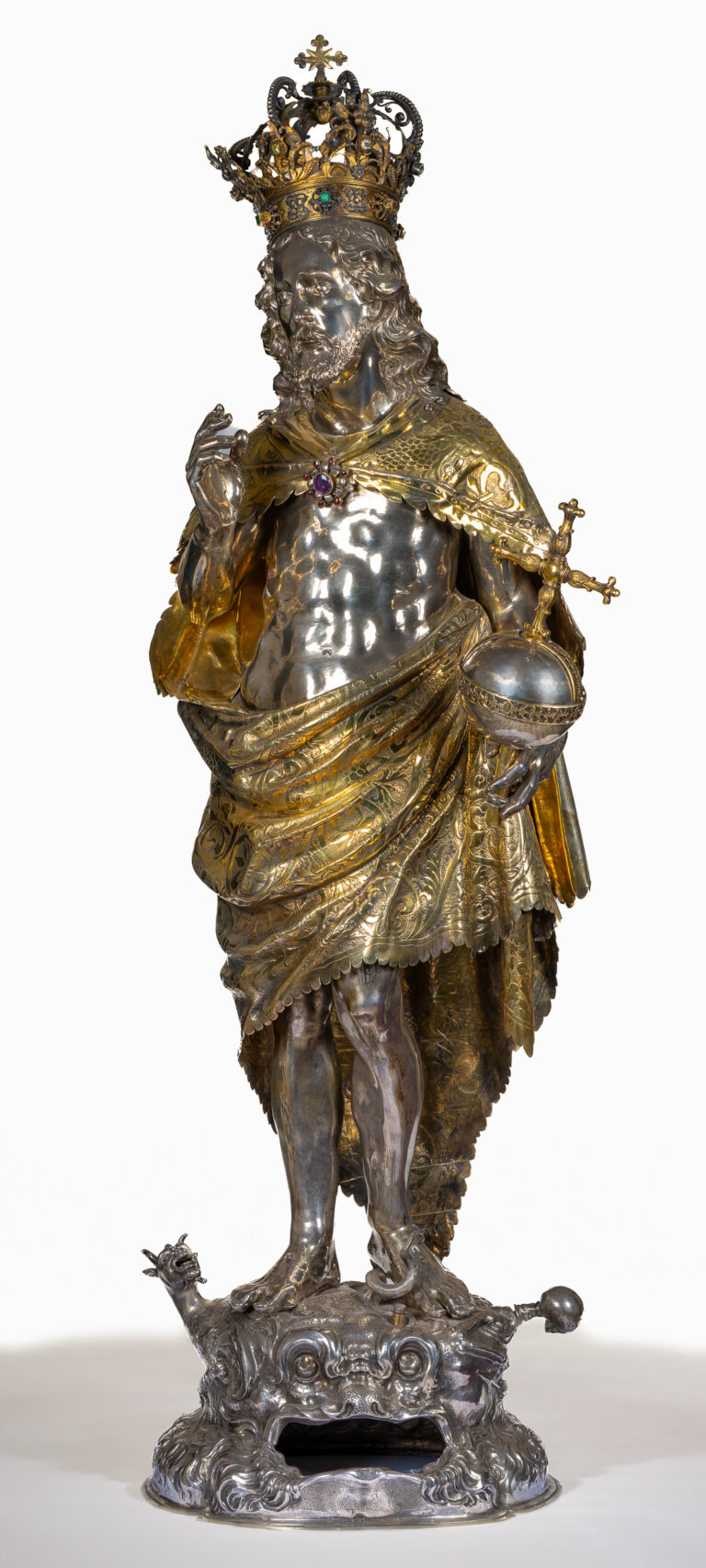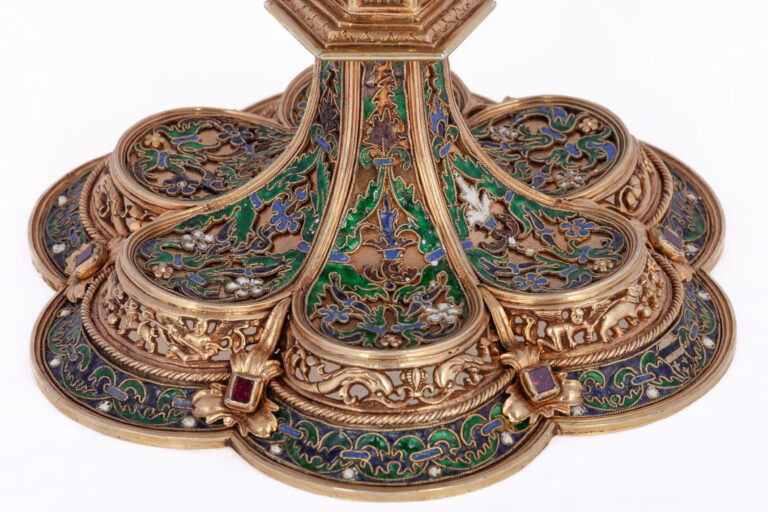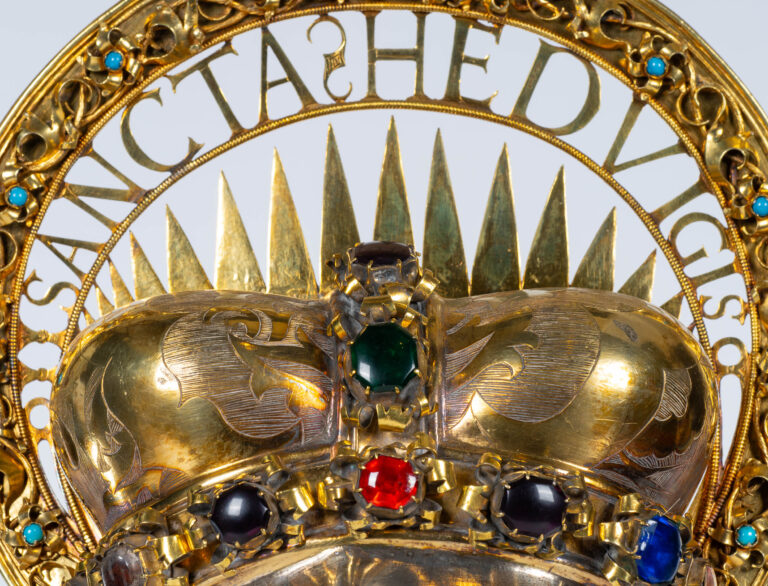The Cathedral
of St. John the Baptist
in Wroclaw
explore
About Project
Dissemination
through digitisation
An interactive virtual platform was created as part of the project „Dissemination through 2D/3D digitisation of the Cathedral of St John the Baptist in Wroclaw – Mother of the Churches of Silesia”, carried out by the Cathedral Parish of St John the Baptist in Wrocław in partnership with the Foundation for the Virtualisation of National Cultural Heritage in Gorzow Wielkopolski.
The task was to faithfully, virtually recreate the most important part of the Monument of History – the Cathedral of St John the Baptist in Wrocław and the movable monuments contained therein by means of two- and three-dimensional digitisation. The main objective of the project was to develop and digitise cultural heritage resources and make the digital resources available and reusable for popularisation, education, scientific purposes and future conservation research and restoration work.
The project is being implemented with the aim of creating a precise and effective tool for the management and preservation of the historic space of the church for conservationists and art historians, architects and building experts, fire specialists, investigative and litigation bodies.
With this project, the cathedral parish is implementing the latest global standards in the field of historic preservation, with particular emphasis on conservation (digital application for managing the church’s digitally inventoried collection) and security (3D models of the church’s architecture and movable monuments, HDR digital spherical gigapanoramas, gigapixel digital reproductions and gigapixel photographic documentation).
In line with the long-term goals of the Cathedral parish, the project is the first phase of digitalisation of the cultural heritage resources gathered within the parish, which are the most important part of the Monument of History „Wroclaw – historical centre complex”. In addition to the Cathedral of St. John the Baptist, the Gothic Collegiate Church of the Holy Cross and St. Bartholomew, the late Romanesque Church of St. Idzi from the first half of the 13th century, the splendid Statue of St. John of Nepomuk unveiled by Johann Georg Urbansky and Johann Albrecht Siegwitz between 1730 and 1732, and the oldest surviving monument in Wroclaw„”the statue of Our Lady of the Immaculate Conception with Child from 1694, located in front of the main entrance to the Cathedral.
In the years to come, the applicant intends to continue the digitalisation activities, which will determine changes in the sphere of communication between the monuments and their surroundings. A significant increase in the number of people (including people with disabilities and the elderly) who become acquainted with the priceless monuments of the parish, which are outstanding monuments of supra-regional significance, is expected.
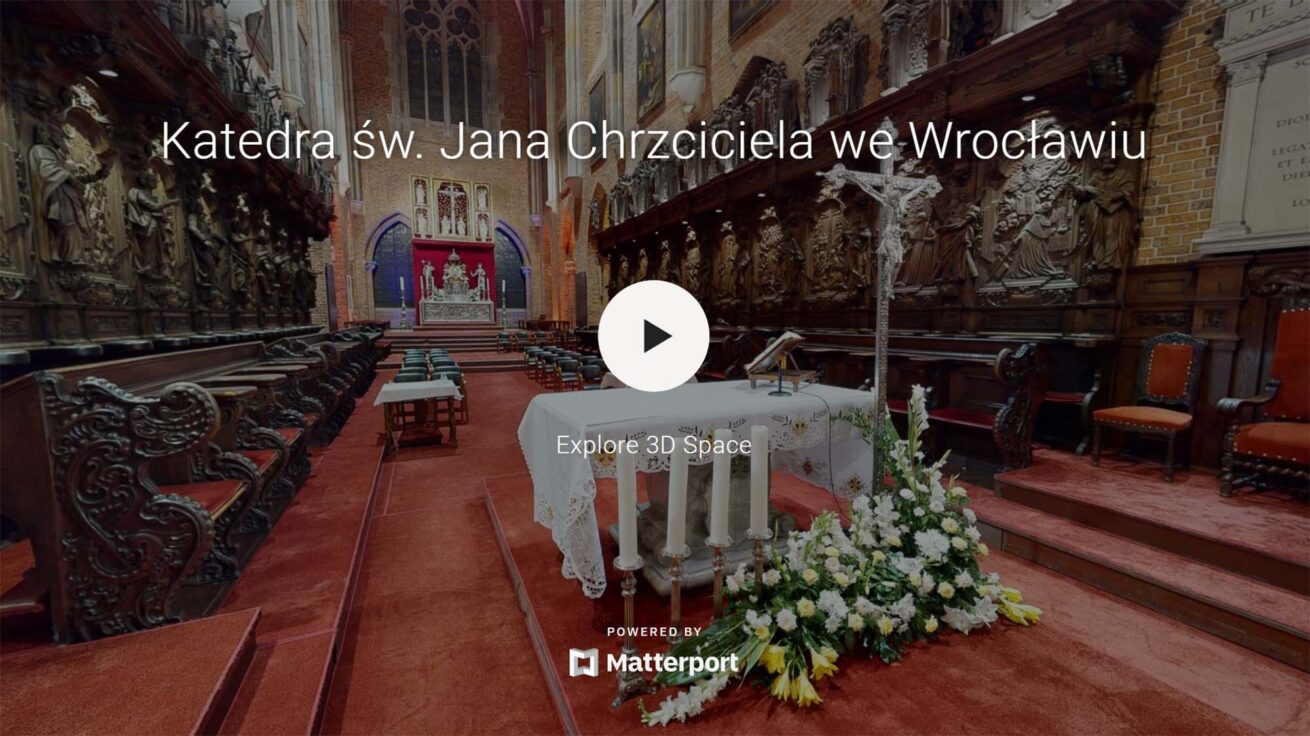
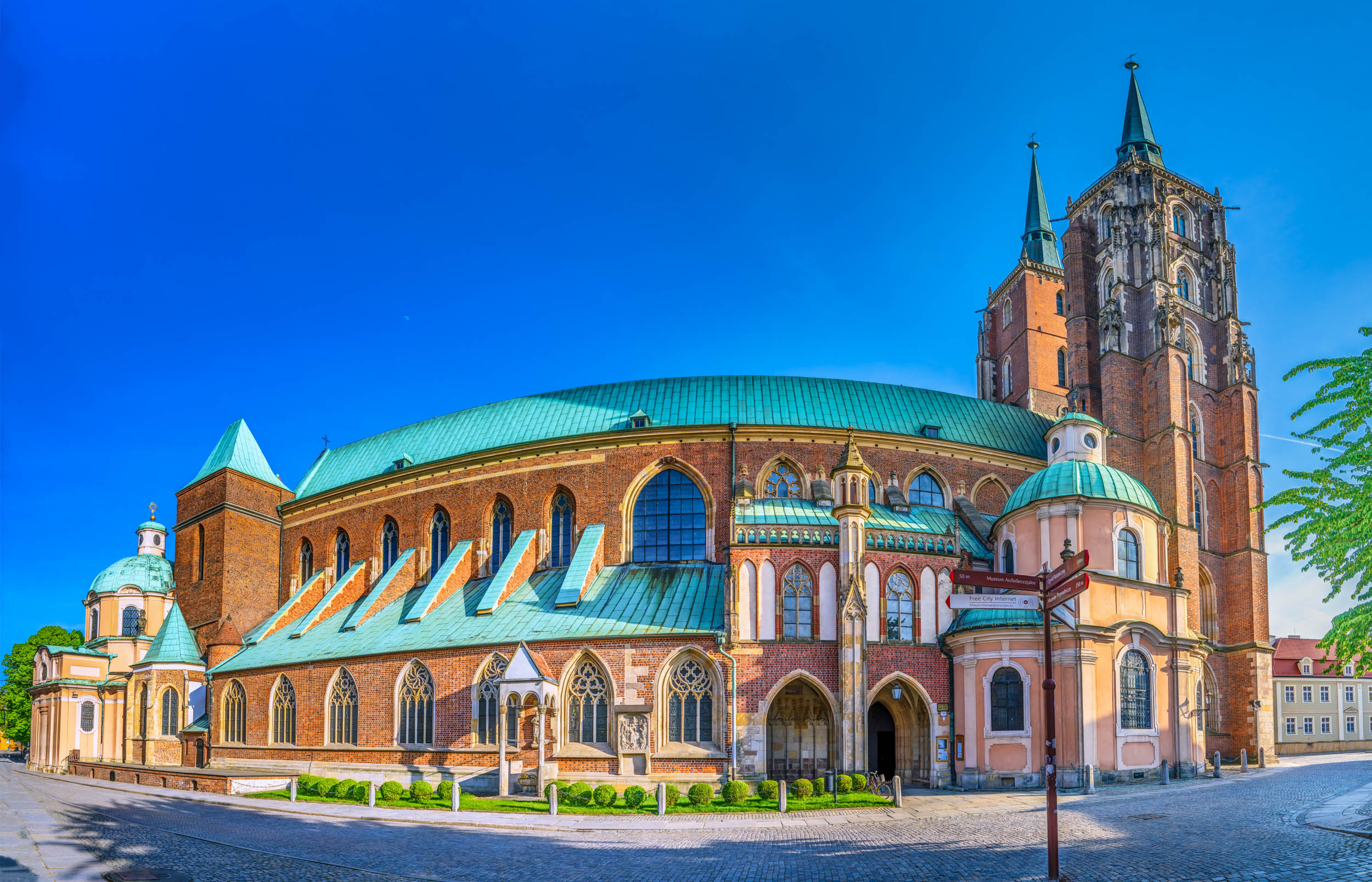
Promotion of Culture
The name of the programme: Digital Culture.
The name of the task: Dissemination through 2D/3D digitisation of the Cathedral of Saint John the Baptist in Wrocław – Mother of Churches of Silesia.
Grant value: PLN 117,000.
Total value: 180 100 zł.
Task description: The primary objective of the project was the faithful, digital, three-dimensional and virtual reconstruction of the architecture of a fragment of the Monument of History – the Cathedral of St John the Baptist in Wrocław and the movable relics located therein (painting, sculpture, artistic craftsmanship, blacksmithing, etc.), through two- and three-dimensional digitisation. The scope of work will cover the entire church and the outstanding and valuable works of art within it. State-of-the-art measurement and visualisation technologies and web technologies (multilingual, responsive website) will be used during the task, ensuring interactivity for all types of audience, with particular emphasis on excluded people (WCAG 2.1 standard).
Subsidised by funds from the Ministry of Culture and National Heritage from the Fund for the Promotion of Culture – a state purpose fund.
The project partner/donor is the PKO Bank Polski Foundation. Guided by the motto “Good pays off”, since 2010. The Foundation has been working for the public good, inspiring various circles and influencing local communities by creating social conditions that enable everyone to function properly.

History
Mother of the churches of Silesia
The Cathedral of St John the Baptist, Archbishop of Wroclaw, was built in the Gothic style between 1244 and 1341, and is one of the landmarks of Wroclaw – the meeting place. Its two towers, almost 98 meters high, are the tallest church towers in the city and, like those in Brno, Prague and Vienna, dominate the cityscape.

Architecture
Architecture
of the cathedral
The present fourth cathedral dates essentially from the Gothic period, from the 13th to the 14th century. However, it was preceded by 3 other churches on the same site. The present shape is the result of Baroque additions and contemporary restorations after wartime damage. It is regarded as the first fully Gothic church on Polish soil.
The cathedral is a three-nave oriented Gothic basilica with an ambulatory and a quadrilateral choir 98 m long and 44.5 m wide. Both the west and east elevations are flanked by towers, the eastern of which has remained unfinished since the late Middle Ages. The cathedral has three entrances: the main one, to the west, leading through a portal house, and two side entrances, to the north and south.
The cathedral is surrounded by a wreath of chapels dating mostly from the Gothic period. It also has four Baroque chapels of varying size. The facades of all the Baroque chapels were renovated in 1997, prior to the Eucharistic Congress in 1997 and the Jubilee Year 2000 celebrations, giving them an intense colour scheme similar to their original colours.
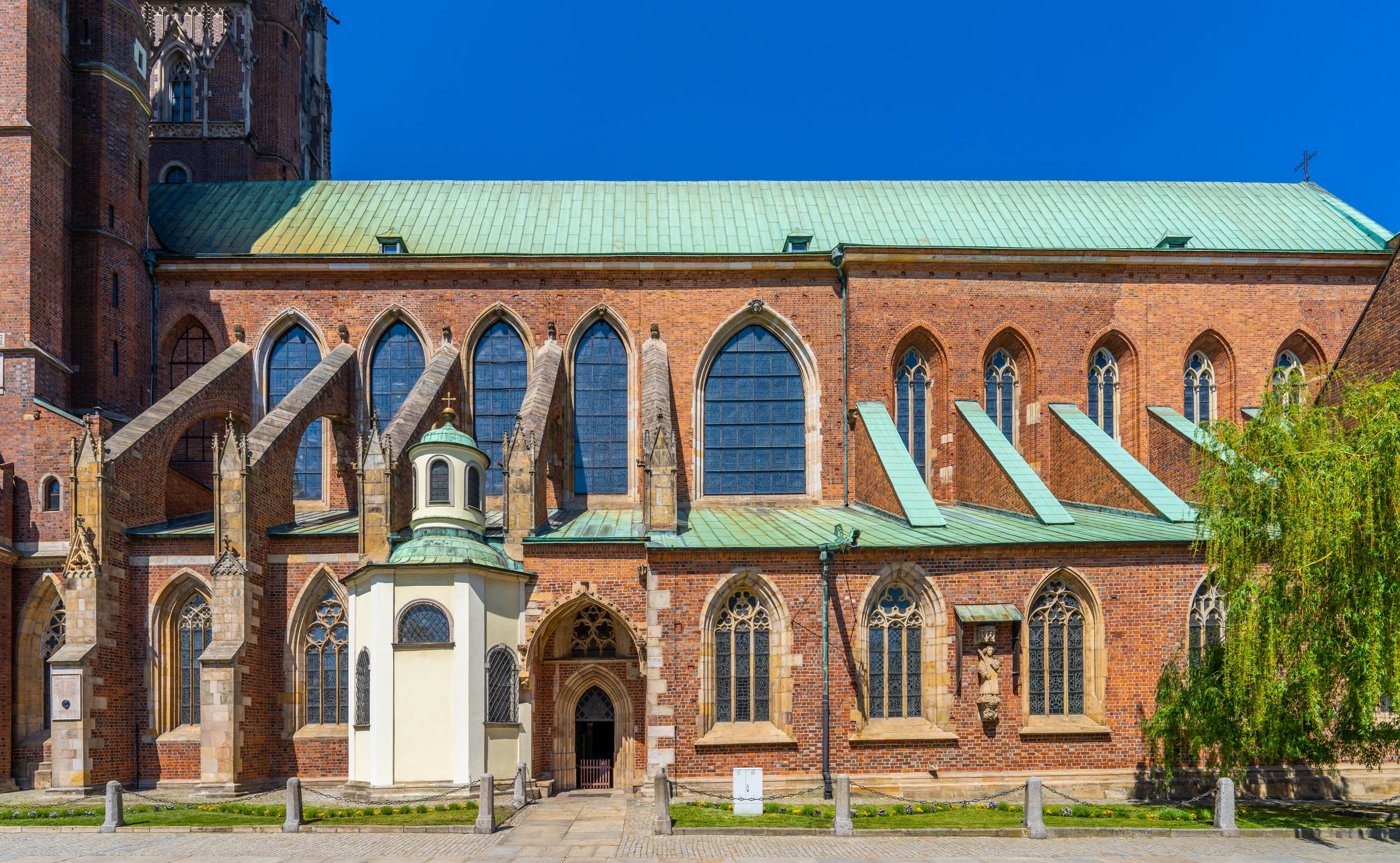
 Panorama lotnicza Ostrowia Tumskiego, najstarszej, zabytkowej części Wrocławia
gigapixel
Panorama lotnicza Ostrowia Tumskiego, najstarszej, zabytkowej części Wrocławia
gigapixel
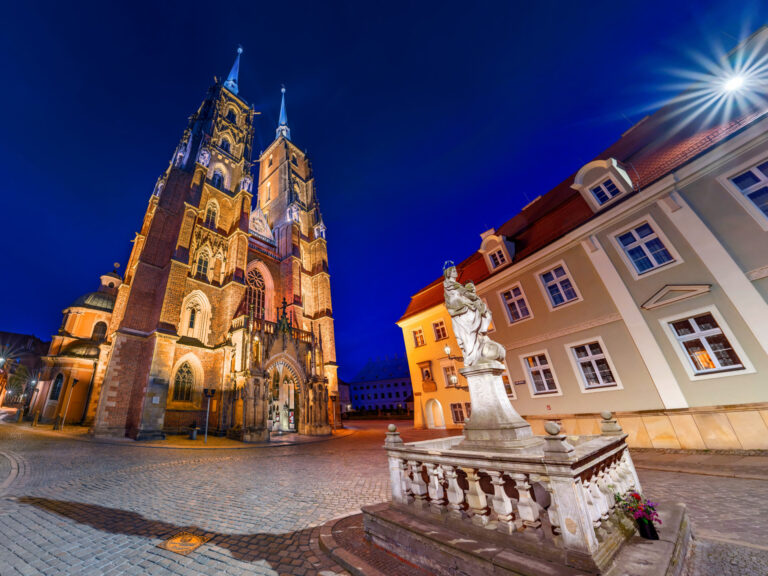 Gigapanorama nocna fasady Katedry św. Jana Chrzciciela we Wrocławiu
gigapixel
Gigapanorama nocna fasady Katedry św. Jana Chrzciciela we Wrocławiu
gigapixel
 Gigapanorama nocna Ostrowia Tumskiego we Wrocławiu
gigapixel
Gigapanorama nocna Ostrowia Tumskiego we Wrocławiu
gigapixel
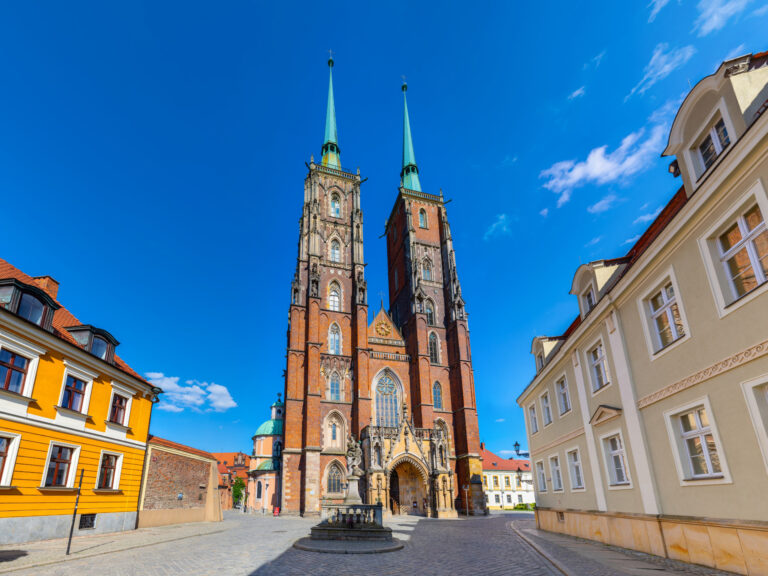 Gigapanorama fasady Katedry św. Jana Chrzciciela we Wrocławiu
gigapixel
Gigapanorama fasady Katedry św. Jana Chrzciciela we Wrocławiu
gigapixel
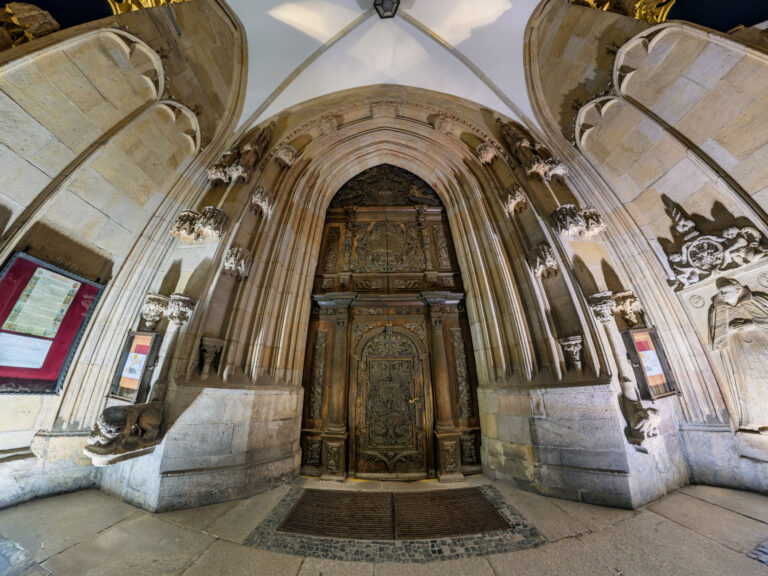 Gigapanorama wnętrza portalu zachodniego Katedry św. Jana Chrzciciela we Wrocławiu
gigapixel
Gigapanorama wnętrza portalu zachodniego Katedry św. Jana Chrzciciela we Wrocławiu
gigapixel
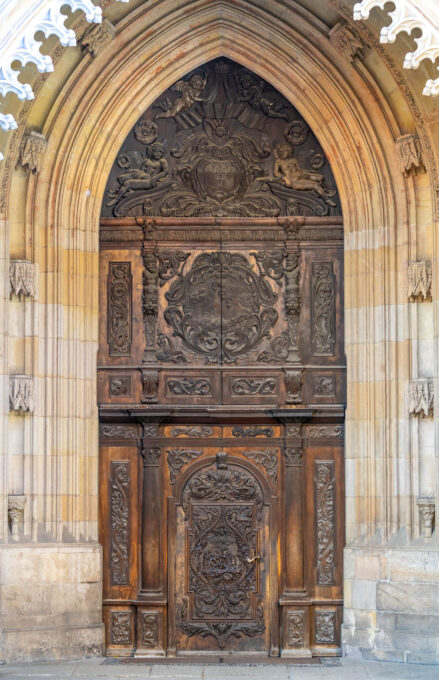

Head of Christ:
Presbytery and ambit
The architecture of the six-bay choir is reminiscent of cathedral Gothic and has a strongly vertical articulation of the interior. The consoles, on which the suspended servants rest, are of a modern highly simplified form and date from the 1930s. The choir is vaulted with three hexagonal vaults, while the bypass is vaulted with cross-ribbed vaults. The marble floor of the choir is raised by three steps in relation to the nave, the eastern, altar bay by a further four.
From the 16th century, the main altar of the cathedral was a Mannerist figurative altar funded by Bishop Jerin. As of December 2019, it is again the main altar. The Baroque stalls from 1662-1665 by Franz Mots and Franz Zeller are from the Church of St Vincent. The tall and heavy stalls with numerous bas-relief representations almost completely cover the arcades, which are open towards the ambit. In the windows are post-war stained glass windows designed by Polish artists, including Zygmunt Acedański, Irena Nowakowska-Acedańska, Stanisław Pękalski and Antoni Michalak.
Under the arcades dividing the ambit from the choir, confessionals were built, accessible from the ambit, and attached to the rear walls of the stalls. The ambit has a rich stonework decoration of capitals and keystones with figural representations and coats of arms. Moreover, the portal connecting the southern part of the ambulatory with the sacristy, one of the first Renaissance works in Silesia, is worth mentioning. The ambit is separated from the side aisles by a grille and is only accessible to a limited extent.
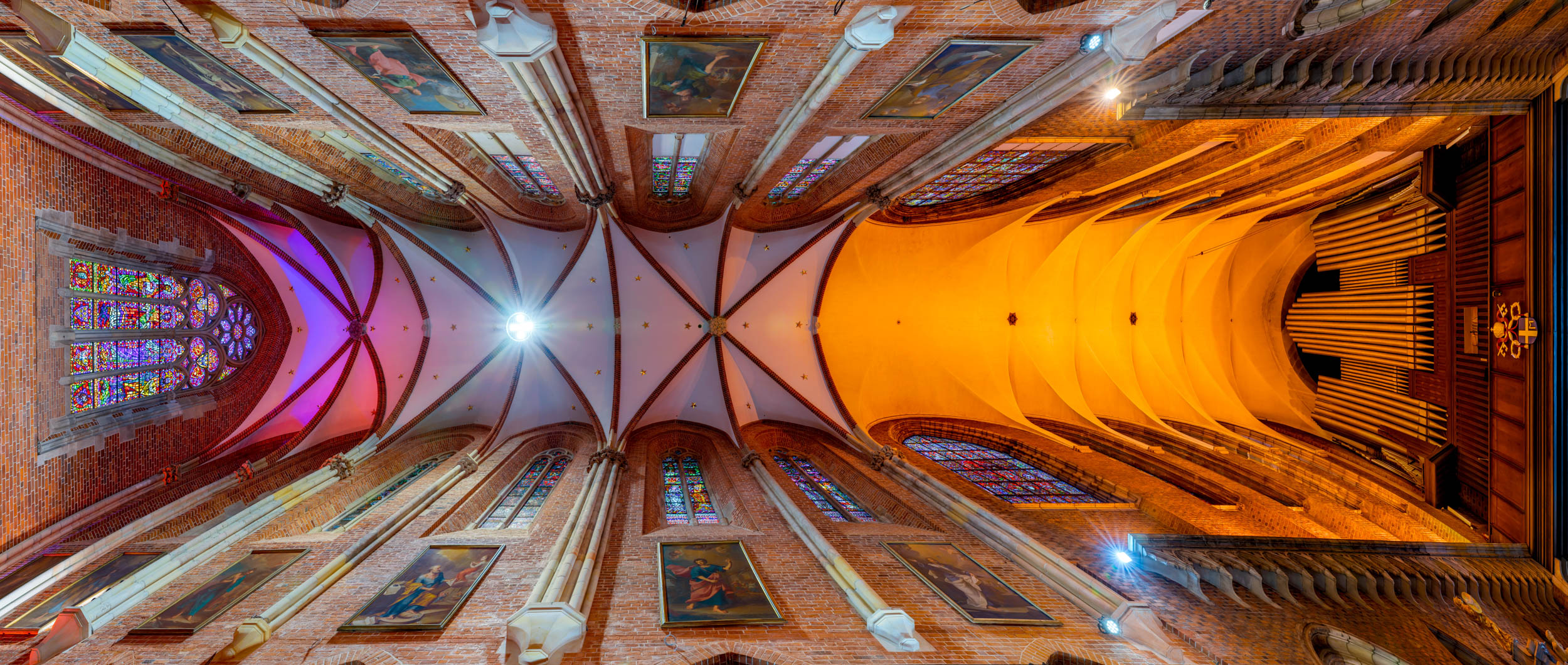
Oak stalls -
St. Norbert of Xanten
The Baroque oak stalls from 1662-1665 by Bavarian artists Franz Motsch and Josef Zeller come from the church of St. Vincent in Breslau belonging to the Norbertine monastery. They feature bas-reliefs with scenes from the life of St Norbert of Xanten (1082-1134), founder of the order in Prémontré near Laon, France.
The beginning of the cycle of these depictions is on the south-east side and depicts the coat of arms of Abbot Matthäus Paul, who brought the above-mentioned artists to Breslau. Figures of the Apostles, Evangelists and Fathers of the Church are placed between the reliefs, with sculptures of Angels with the instruments of the Passion in the finial.

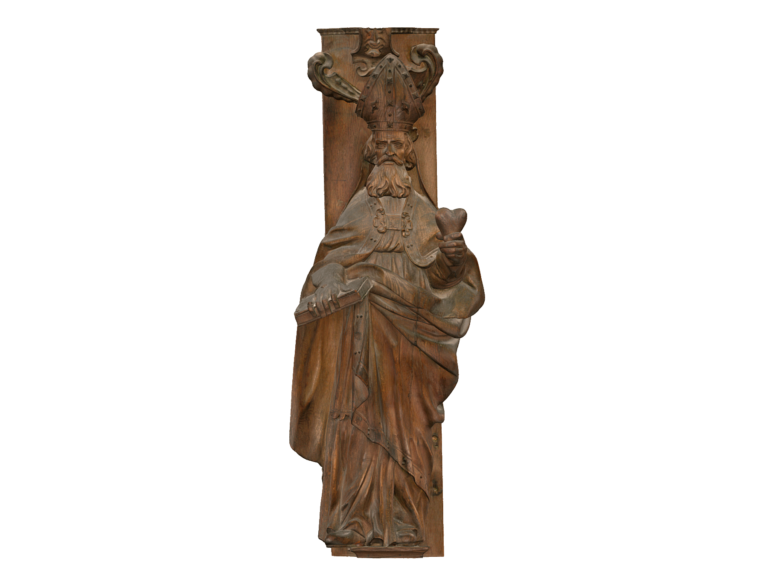 Saint Augustine
3D MODEL
Saint Augustine
3D MODEL
 Coat of arms of the Abbot Matthäus Paul
3D MODEL
Coat of arms of the Abbot Matthäus Paul
3D MODEL
 Saint Gregory
3D MODEL
Saint Gregory
3D MODEL
 Conversion of Saint Norbert
3D MODEL
Conversion of Saint Norbert
3D MODEL
 Saint Mark the Evangelist
3D MODEL
Saint Mark the Evangelist
3D MODEL
 Saint Norbert distributes his wealth to the poor
3D MODEL
Saint Norbert distributes his wealth to the poor
3D MODEL
 Saint Matthew the Apostle
3D MODEL
Saint Matthew the Apostle
3D MODEL
 Saint Norbert restores peace
3D MODEL
Saint Norbert restores peace
3D MODEL
 Saint Simon the Apostle
3D MODEL
Saint Simon the Apostle
3D MODEL
 Saint Norbert drinks a spider during Mass along with the Holy Blood
3D MODEL
Saint Norbert drinks a spider during Mass along with the Holy Blood
3D MODEL
 Saint Bartholomew the Apostle
3D MODEL
Saint Bartholomew the Apostle
3D MODEL
 Our Lady gives Saint Norbert the garb of the Order
3D MODEL
Our Lady gives Saint Norbert the garb of the Order
3D MODEL
 The vision of the Holy Cross shows Saint Norbert’s successor the site for the church
3D MODEL
The vision of the Holy Cross shows Saint Norbert’s successor the site for the church
3D MODEL
 Saint John the Evangelist
3D MODEL
Saint John the Evangelist
3D MODEL
 Saint Norbert overcomes evil (bear symbol)
3D MODEL
Saint Norbert overcomes evil (bear symbol)
3D MODEL
 Saint Andrew the Apostle
3D MODEL
Saint Andrew the Apostle
3D MODEL
 Saint Norbert is visited by St. Augustine to hand down his monastic rule
3D MODEL
Saint Norbert is visited by St. Augustine to hand down his monastic rule
3D MODEL
 Saint Peter the Apostle
3D MODEL
Saint Peter the Apostle
3D MODEL
 Saint John the Baptist
3D MODEL
Saint John the Baptist
3D MODEL
 Pope Honorius II hands over to Saint Pope Honorius II presents Saint Norbert with the document approving the existence of the Order
3D MODEL
Pope Honorius II hands over to Saint Pope Honorius II presents Saint Norbert with the document approving the existence of the Order
3D MODEL
 Saint James the Elder Apostle
3D MODEL
Saint James the Elder Apostle
3D MODEL
 Counts and princes, having entered the Order, lay the insignia of power at the feet of the Virgin Mary
3D MODEL
Counts and princes, having entered the Order, lay the insignia of power at the feet of the Virgin Mary
3D MODEL
 Saint James the Younger Apostle
3D MODEL
Saint James the Younger Apostle
3D MODEL
 The triumph of Saint Norbert over the heresy of Tanchelini
3D MODEL
The triumph of Saint Norbert over the heresy of Tanchelini
3D MODEL
 Saint Thomas the Apostle
3D MODEL
Saint Thomas the Apostle
3D MODEL
 Saint Norbert casts out evil spirits
3D MODEL
Saint Norbert casts out evil spirits
3D MODEL
 Saint Matthew the Evangelist
3D MODEL
Saint Matthew the Evangelist
3D MODEL
 Saint Norbert heals a blind woman
3D MODEL
Saint Norbert heals a blind woman
3D MODEL
 Saint Philip the Apostle
3D MODEL
Saint Philip the Apostle
3D MODEL
 Saint Norbert arrives with Lothar III for the imperial coronation
3D MODEL
Saint Norbert arrives with Lothar III for the imperial coronation
3D MODEL
 Saint Luke the Evangelist
3D MODEL
Saint Luke the Evangelist
3D MODEL
 Saint Norbert with Saint Bernard of Clairvaux as advisors to Emperor Lothar III
3D MODEL
Saint Norbert with Saint Bernard of Clairvaux as advisors to Emperor Lothar III
3D MODEL
 Saint Stephen the Martyr
3D MODEL
Saint Stephen the Martyr
3D MODEL
 Death of Saint Norbert
3D MODEL
Death of Saint Norbert
3D MODEL
 Saint Ambrose, Father of the Church
3D MODEL
Saint Ambrose, Father of the Church
3D MODEL
 Cartouche with the Virgin Mary on the sickle of the moon
3D MODEL
Cartouche with the Virgin Mary on the sickle of the moon
3D MODEL
Ambulatory Chapels
Saint Elizabeth
Chapel
Theatrum
sacrum
The Baroque chapel of St Elizabeth, adjacent to the south-east tower to the east, was built between 1682 and 1700 by the Italian architect Giacomo Scianzi, who also did the frescoes of the dome. The sculptures are the work of Domenico Guidi and Ercole Ferrata. The founder of the chapel was Duke Frederick of Hesse, who entered the Wroclaw cathedral chapter in 1666 and became its dean two years later. In 1671 he received the episcopal sacrament and was ordained a priest.
The chapel has its own vestry adjoining to the east, covered by a pulpit roof, and a separate south-facing presbytery. The nave is covered by a cradle and in the central part by a cupola with a lantern set on a drum of elliptical plan. The chapel contains the tomb of the founder (on the north side) and an altar with a statue of St Elizabeth of Hungary (on the south side). The walls are covered with frescoes by Andrzej Kowalski depicting scenes from the life of the patroness. Above the entrance to the chapel is a bust of its founder from Bernini’s workshop.
The chapel was built on an elongated rectangular plan with an altar annex and sacristy. The main part was covered with a cupola. The division of the walls, the introduction of columns, cornices and ornaments, and the combination of wall painting and stucco give a sense of fluidity and dynamism and the impression of more space. The play of light coming through the windows and the dome is important, directing the viewer’s gaze to the south wall and the niche framed by pairs of columns with the altar of St. Elisabeth, and then to the north wall, which is the backdrop for the founder’s stately tomb.
The wall painting depicts St Elizabeth’s works of mercy and the end of her short life, presented in the perspective of the open gates of the Kingdom of Heaven and its inhabitants coming out to welcome her.

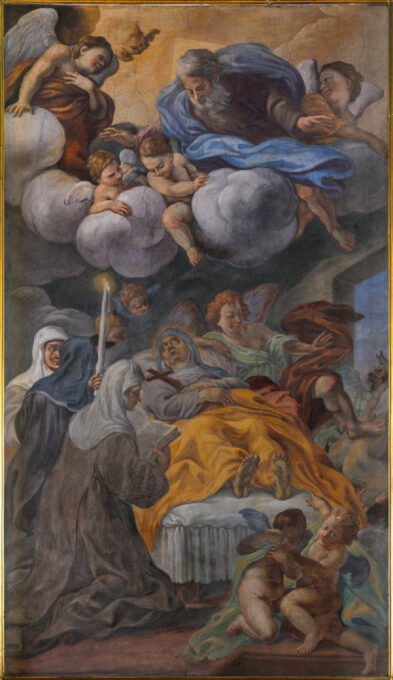 Obraz „Śmierć św. Elżbiety” autorstwa Andrzeja Kowalskiego i Sebastiana Muskarsema z 1700 r.
gigapixel
Obraz „Śmierć św. Elżbiety” autorstwa Andrzeja Kowalskiego i Sebastiana Muskarsema z 1700 r.
gigapixel
 Obraz „Cuda przy trumnie Św. Elżbiety” autorstwa Andrzeja Kowalskiego i Sebastiana Muskarsema z 1700 r.
gigapixel
Obraz „Cuda przy trumnie Św. Elżbiety” autorstwa Andrzeja Kowalskiego i Sebastiana Muskarsema z 1700 r.
gigapixel
 Fresk w kopule kaplicy św. Elżbiety autorstwa Giacomo Scianzi, przedstawiające sceny z życia świętej z 1700 r.
gigapixel
Fresk w kopule kaplicy św. Elżbiety autorstwa Giacomo Scianzi, przedstawiające sceny z życia świętej z 1700 r.
gigapixel


 Cartouche with allegory of the Catholic Church
3D MODEL
Cartouche with allegory of the Catholic Church
3D MODEL
 The allegory of Truth trampling the allegory of Lies
3D MODEL
The allegory of Truth trampling the allegory of Lies
3D MODEL

Saint Mary's
Chapel
Tomb chapel
of Przecław of Pogorzela
The St. Mary’s Chapel on the axis of the cathedral, known as the ‘little choir’, was founded by the Bishop of Wrocław, Przecław of Pogorzela, in the fourteenth century and executed by Master Pieszka as a chapel of the Mansionary College. The chapel is single-nave, two-bay with a separate narrower quadrilateral also two-bay chancel.
The west bay of the chancel is cross-vaulted, the other bays have five-bay vaults. In the central part of the chapel is the sarcophagus of the founder, a magnificent bronze cast tombstone of Bishop Jan Roth (hierarch of Wrocław from the turn of the 15th and 16th centuries) by Peter Vischer the elder from 1503, and numerous epitaphs. Before the war, the chapel also housed a statue of the Madonna and Child from the mid-19th century. The statue miraculously survived the war effort and is now in the pulpit. The main altar of the chapel is Baroque and contains a copy of the painting of Our Lady of Czestochowa.
Przecław of Pogorzela is a landmark figure in the history of the Bishopric of Wrocław. His predecessor, Bishop Nanker, who still remembered the times when Silesia belonged to Poland, could not come to terms with the new political realities and therefore came into conflict with the ruling Luxembourg dynasty. John of Luxemburg found support among the burghers of Breslau, who, taking advantage of the prevailing situation, committed rape on church property. After Nanker’s death, his successor on the bishop’s seat, Przeclaw of Pogorzela, eased the conflict with the ruler and the town council by pledging loyalty to the ruling dynasty. Przeclaw not only took care of the economic development of the bishopric, bringing it to prosperity, but also remembered to maintain the moral level of the clergy. The bishop set up poorhouses and supported the establishment of new monastic institutions.
The time of the reign of Przeclaw of Pogorzela is, in ecclesiastical historiography, the “golden age” of the Bishopric of Wroclaw.

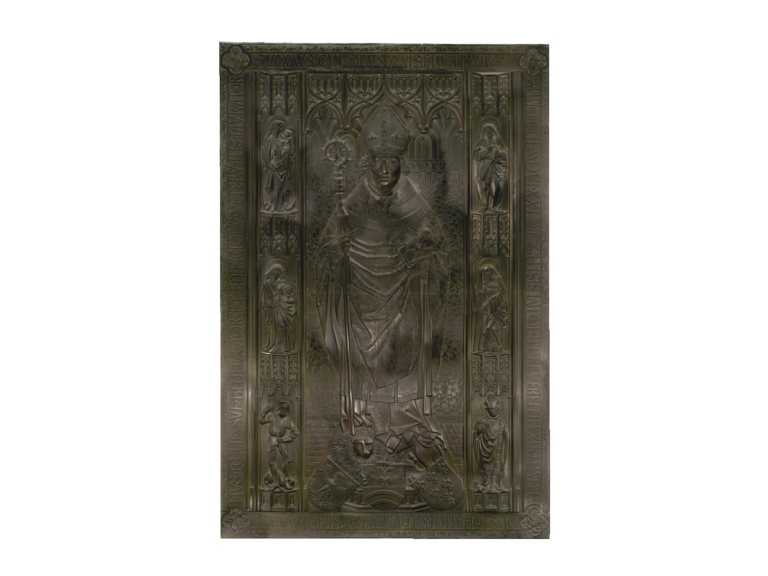 3D model of the bronze tombstone of Bishop John IV Roth made by Peter Vischer the Elder in 1503.
3D MODEL
3D model of the bronze tombstone of Bishop John IV Roth made by Peter Vischer the Elder in 1503.
3D MODEL
 Saint George slaying the dragon
3D MODEL
Saint George slaying the dragon
3D MODEL
 WrocKat_8_2
3D MODEL
WrocKat_8_2
3D MODEL
 WrocKat_8_3
3D MODEL
WrocKat_8_3
3D MODEL
 WrocKat_8_4
3D MODEL
WrocKat_8_4
3D MODEL
 The sarcophagus of Bishop Przeclaw of Pogarella
3D MODEL
The sarcophagus of Bishop Przeclaw of Pogarella
3D MODEL
 WrocKat_4_1
3D MODEL
WrocKat_4_1
3D MODEL
 WrocKat_4_2
3D MODEL
WrocKat_4_2
3D MODEL
 WrocKat_4_3
3D MODEL
WrocKat_4_3
3D MODEL
 WrocKat_4_4
3D MODEL
WrocKat_4_4
3D MODEL
Electors' Chapel
Old and New Testaments
in paintings
The Baroque Corpus Christi Chapel, also known as the Elector Chapel, adjacent to the north-east tower, was built between 1716 and 1724. The chapel was founded as his mausoleum by Bishop Ludwig Franz von Pfalz-Neuburg, who, while bishop of Trier and Mainz, was one of the Electors of the German Reich – hence the name of the chapel. It was designed by the famous Viennese architect Johann Bernhard Fischer von Erlach. The painting decoration was done by Carlo Carlone, the sculptural work is by Ferdinand Maximilian Brokoff.
The decoration of the altar as well as the entire cathedral is a unique reference to the tradition of the Old Testament and its fulfilment in the New. Thus, in the main altar one can see Moses and Aaron and in the central place the Ark of the Covenant. On the opposite side of the altar next to Jesus on the cross is Moses.
Among the decorations in the chapel, the paintings by Johann Franz de Backer are particularly noteworthy. The frescoes in the dome depicting the rebellion and the casting down of Lucifer are the work of Carlo Carlone. Among the frescoes, we also find images of the Evangelists and Doctors of the church. Above the lantern are four Hebrew letters (yod, he, waw, he), which in the Old Testament signified the Name of God.
This chapel too has a dome with a lantern set on a drum with an elliptical projection. Maria Kazimiera Sobieska, granddaughter of John III Sobieski, is buried in the chapel.
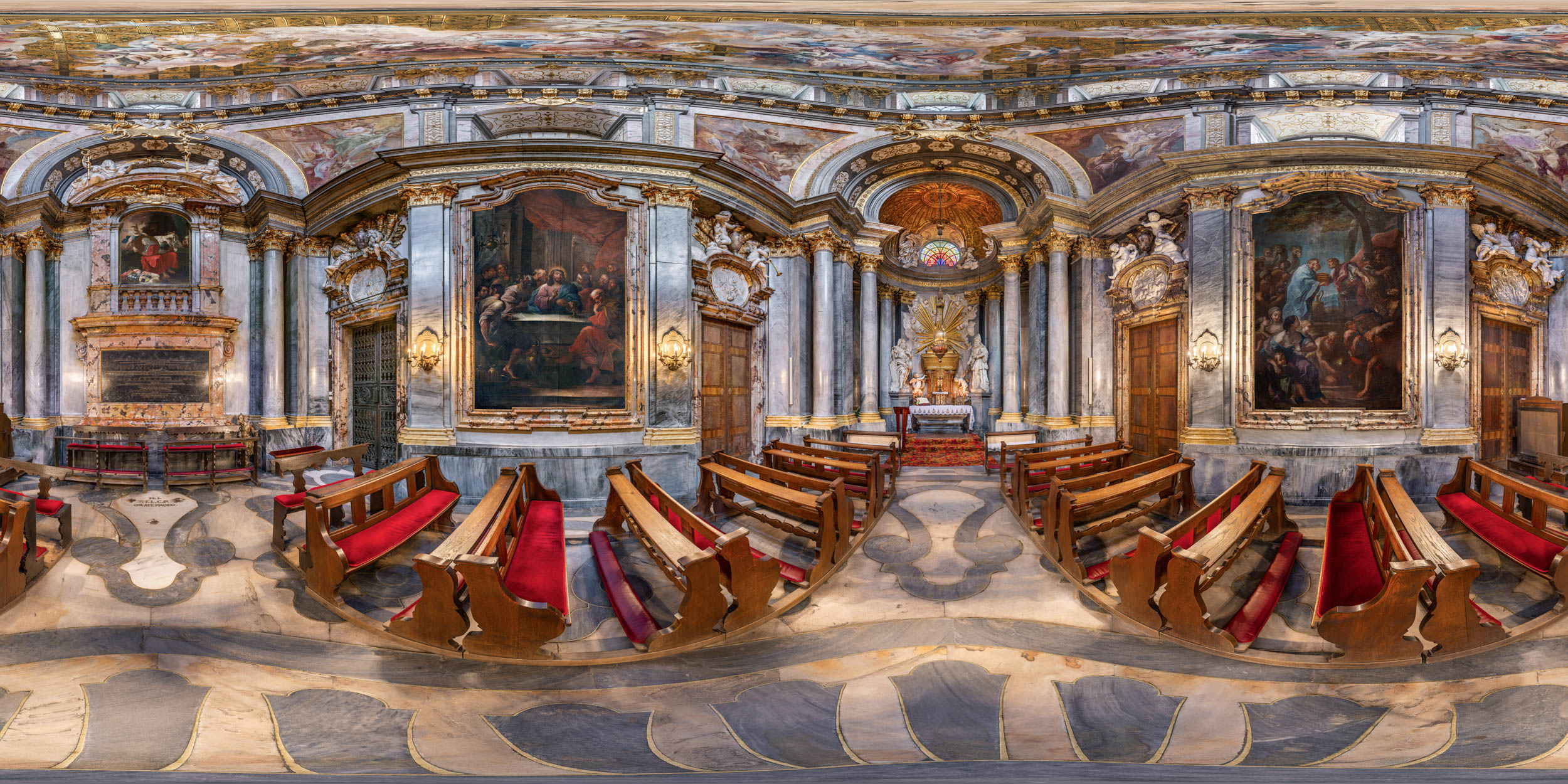
Painting
The image
of Our Lady of Sobieski
Mother of Adoration
Giovanni Battista Salvi (born 1605 in Sassoferrato, died 1685 in Rome) was one of the most popular Roman painters of the Baroque era. He became most famous for his Marian images, which were transformed from 15th-century Dutch graphic designs and works by Renaissance masters.
The image of Our Lady of Sobieski belongs to a larger group of images described as the Comforter of the Afflicted. Mary is depicted in a half pose, with her head slightly bent over her right shoulder. Her head and shoulders are covered by a voluminous sapphire cloak, under which a white veil is partly visible, covering her hair. The subtle modelling of the face and the characteristically folded hands was achieved with soft, invisible brushstrokes.
Attention is drawn to Mary’s gentle eyes. Some see in this gaze a supernatural phenomenon, as expressed in the popular title – ‘With Eyes That Lead’. The impression of a vivid gaze was created by the painter on the basis of keen observation combined with virtuosity. The dark background is illuminated by a delicate halo. In 1750, the painting received a silver gilt ‘dress’, decorated in the mantle part with a pattern of flowers and leaves. The embossing in the metal repeats the outline of the robes, so only Mary’s face and hands are now visible.
In 1713, Pope Clement XI offered the painting to Alexander Sobieski, a Polish royal resident in Rome, as the Church’s thanksgiving for the relief of Vienna. After his death († 1714), the painting went to one of his brothers, Jacob, lord of Olawa. In 1750, Count Michael von Althan of Międzylesie became its next owner. He placed it in the main altar of the parish church.
In 1831, after the church had been redecorated, the painting was moved to the side wall of the presbytery, setting it in a rich frame. In 1951, by a decision of the church authorities, it was moved to Wrocław Cathedral. It was placed in the late Baroque side altar by the presbytery pillar. During his pilgrimage to Wrocław on 31 May 1997, St John Paul II gave the image the title Mater Adorans – Mother of Adoration – and adorned it with a crown.

Easel
paintings
The most valuable painting in the Wrocław Cathedral until 1943 was the “Madonna under the firs” from 1510 by the German painter Lucas Cranach the Elder. It depicts Mary with the little Jesus on her knees. Jesus holds a grapevine in his hand, resting on an expensive cushion. Beside her is a gold signet ring with the signature L.C. The background is a mountainous landscape with leaning birch and fir trees.
This is one of the most unique depictions of the subject of Mary with Child, which served as a model for the master’s subsequent work and subsequent generations. It is also considered to be the most beautiful of the Madonnas that came out from under Cranach’s brush.
Around 1517, the Madonna under the firs by Lucas Cranach the Elder was hung in the Chapel of the Fourteen Helpers, now the Chapel of St John the Evangelist in the Cathedral of Wrocław. It remained there until the end of the 19th century, when it was decided to move the work to the cathedral treasury (which demonstrates the awareness of the high artistic quality of the work at the time).
In 1943, by order of the German authorities – for fear of Allied air raids – the Madonna under the firs, together with other objects, was transported to the Henryków monastery, and shortly afterwards to Kłodzko. After the capture of the city by the Russians, Kurt Engelbert, director of the Diözesanmuseum (now the Archdiocesan Museum in Wrocław), brought Cranach’s work to Wrocław and placed it in the museum he managed, as the cathedral was already in ruins at the time. After the war, the Germans secretly transported the original painting and replaced it with a copy, a fact that was only discovered in 1961.
After many vicissitudes, it was only in 2012 that the painting by Lucas Cranach the Elder returned to the Archdiocesan Museum in Wrocław, being the most valuable painting recovered by Poland after the last war.

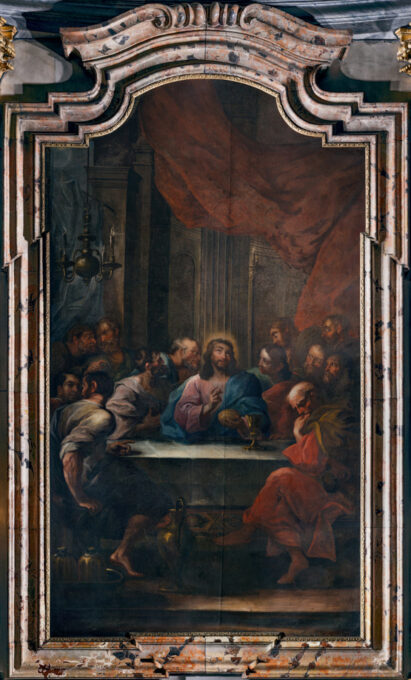 Obraz „Ostatnia Wieczerza” autorstwa Johanna Franza de Backera z Antwerpii z 1724 r.
gigapixel
Obraz „Ostatnia Wieczerza” autorstwa Johanna Franza de Backera z Antwerpii z 1724 r.
gigapixel
 Obraz „Ofiara Kapłana Melchizedecha”autorstwa Johanna Franza de Backera z Antwerpii z 1724 r.
gigapixel
Obraz „Ofiara Kapłana Melchizedecha”autorstwa Johanna Franza de Backera z Antwerpii z 1724 r.
gigapixel
 Portret fundatora Kaplicy Elektorskiej Franciszka Ludwika von Neuburga z epitafium nagrobnego – 1776 r.
gigapixel
Portret fundatora Kaplicy Elektorskiej Franciszka Ludwika von Neuburga z epitafium nagrobnego – 1776 r.
gigapixel












Wall
painting
Wroclaw Cathedral has a rich collection of frescoes, particularly in the two chapels behind the presbytery.
The most outstanding decoration of the St. Elizabeth Chapel are the excellent frescoes by Giacomo Scianzi, depicting St Elizabeth’s works of mercy and the end of her short life, presented in the perspective of the open gates of the Kingdom of Heaven and its inhabitants coming out to welcome her. The paintings on the sails of the dome represent an allegory of the virtues of Wisdom, Justice, Temperance and Fortitude.
On the other hand, in the Corpus Christi Chapel, known as the Elector’s Chapel, we find frescoes in the dome depicting the rebellion and the casting down of Lucifer. Among the frescoes, we can also find images of the Evangelists and Doctors of the church.

Stained
glass
windows
The stained glass windows in Wroclaw Cathedral were designed and made by contemporary artists.
In the presbytery there are stained glass windows by Tadeusz Wojciechowski. The window above the altar depicts the patron saints of the cathedral and the city of Wrocław: St. John the Baptist, St. Vincent, St Bartholomew and Henry II the Pious. Below them are images of the head of John the Baptist on a bowl, the coat of arms of the Episcopal principality, the coat of arms of Wroclaw and the head of Henry II the Pious holding a spear. The windows on the south side feature images of the 24 bishops of Wroclaw, from Hieronim (1051-1062) to Piotr Nowak (1447-1456), while on the north side are coats of arms of the deaneries of the Wroclaw archdiocese.
The stained glass windows of the south side of the nave, made by Stanislaw and Krystyna Pekalski, depict the figures of St. Jadwiga, St John Sarkander, St. Albert Chmielowski and the Blessed Virgin Mary with St Maximilian Kolbe.
The stained glass window in the southern window of the pseudo-transept, made by Antoni Michalak, depicts the image of the battle of Legnica, fought in 1241 with the Tatars, in which Henry II the Pious died.
Attention is drawn to the coats of arms of Cardinals Boleslaw Kominek and Henryk Gulbinowicz and Pope John Paul II in the stained glass windows on the north side.

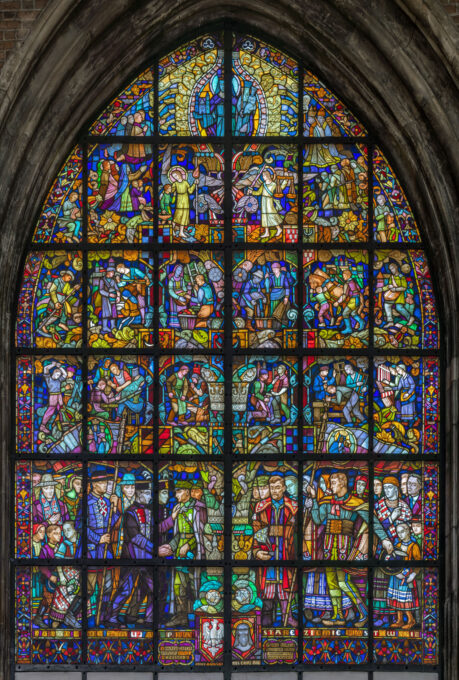 Witraż w północnym oknie pseudotranseptu autorstwa Antoniego Michalaka „Powrót ziem piastowskich do macierzy” z 1956 r.
gigapixel
Witraż w północnym oknie pseudotranseptu autorstwa Antoniego Michalaka „Powrót ziem piastowskich do macierzy” z 1956 r.
gigapixel
 Witraż południowego okna pseudotranseptu autorstwa Antoniego Michalaka przedstawia bitwę pod Legnicą stoczoną z Tatarami w 1241 roku – 1956 r.
gigapixel
Witraż południowego okna pseudotranseptu autorstwa Antoniego Michalaka przedstawia bitwę pod Legnicą stoczoną z Tatarami w 1241 roku – 1956 r.
gigapixel
 Witraż w oknie nawy bocznej „Święta Królowa Jadwiga„ autorstwa Krystyny i Stanisława Pękalskich z 1956 r.
gigapixel
Witraż w oknie nawy bocznej „Święta Królowa Jadwiga„ autorstwa Krystyny i Stanisława Pękalskich z 1956 r.
gigapixel
 Witraż w oknie południowym nawy głównej „Św. Albert Chmielowski„ autorstwa Krystyny i Stanisława Pękalskich z 1956 r.
gigapixel
Witraż w oknie południowym nawy głównej „Św. Albert Chmielowski„ autorstwa Krystyny i Stanisława Pękalskich z 1956 r.
gigapixel
 Witraż w oknie południowym nawy głównej „N.P. Maria ze Św. Maksymilianem Kolbe” autorstwa Krystyny i Stanisława Pękalskich z 1956 r.
gigapixel
Witraż w oknie południowym nawy głównej „N.P. Maria ze Św. Maksymilianem Kolbe” autorstwa Krystyny i Stanisława Pękalskich z 1956 r.
gigapixel
 Witraż w oknie południowym nawy głównej „Błogosławiony Jan Sarkander„ autorstwa Krystyny i Stanisława Pękalskich z 1956 r.
gigapixel
Witraż w oknie południowym nawy głównej „Błogosławiony Jan Sarkander„ autorstwa Krystyny i Stanisława Pękalskich z 1956 r.
gigapixel
 Witraż w oknie kaplicy „Święty Stanisław Biskup„ autorstwa Krystyny i Stanisława Pękalskich z 1956 r.
gigapixel
Witraż w oknie kaplicy „Święty Stanisław Biskup„ autorstwa Krystyny i Stanisława Pękalskich z 1956 r.
gigapixel
 Wielki witraż nad ołtarzem w prezbiterium autorstwa Tadeusza Wojciechowskiego, przedstawiający patronów katedry i miasta Wrocławia – 1956 r.
gigapixel
Wielki witraż nad ołtarzem w prezbiterium autorstwa Tadeusza Wojciechowskiego, przedstawiający patronów katedry i miasta Wrocławia – 1956 r.
gigapixel
 Witraż w kaplicy św. Józefa w nawie południowej
gigapixel
Witraż w kaplicy św. Józefa w nawie południowej
gigapixel
 Witraż w oknie nawy bocznej „Błogosławiona Bronisława„ autorstwa Krystyny i Stanisława Pękalskich z 1956 r.
gigapixel
Witraż w oknie nawy bocznej „Błogosławiona Bronisława„ autorstwa Krystyny i Stanisława Pękalskich z 1956 r.
gigapixel
 witraz-11
gigapixel
witraz-11
gigapixel
 Witraż „NMP, Święta Anna i Święty Joachim” w oknie kaplicy św. Anny w nawa północnej z 1956 r.
gigapixel
Witraż „NMP, Święta Anna i Święty Joachim” w oknie kaplicy św. Anny w nawa północnej z 1956 r.
gigapixel
 witraz-13
gigapixel
witraz-13
gigapixel
 Witraż w oknie nawy bocznej „Święty Stanisław Kostka„ autorstwa Krystyny i Stanisława Pękalskich z 1956 r.
gigapixel
Witraż w oknie nawy bocznej „Święty Stanisław Kostka„ autorstwa Krystyny i Stanisława Pękalskich z 1956 r.
gigapixel
 witraz-15
gigapixel
witraz-15
gigapixel
 witraz-17
gigapixel
witraz-17
gigapixel
Jerin's altar
The silver altar
of Bishop Jerin
The legendary silver high altar, one of the most valuable monuments of the late Renaissance in Poland. Valued at 10,000 thalers, the altar was founded in 1590 by the Catholic Bishop Andreas von Jerin, and made locally in Wrocław by local Lutheran craftsmen under the direction of goldsmith Paul Nitsch. The price of the altarpiece was the equivalent of a medium-sized city when the order was placed for it. After its installation in the cathedral in 1591, it remained its main altar until the end of the Second World War and was one of the most frequently seen monuments in the city. Thus, the cathedral altar made by Lutheran artists became the pride of Silesia’s first Catholic church.
The altar was partially destroyed in 1632 by Swedish and Saxon troops when soldiers stole the silver plates from the back walls of the altar, damaging the chest and side wings in the process. The silver figures were not looted as they were hidden before the city was occupied. In 1650, the altarpiece was restored by order of the bishop’s nephew, Canon Philipp von Jerin, at which time the metal sheets were replaced with cloth decorated with silver stars and rosettes.
During the Second World War, during the operations in front of Festung Breslau, the altar was dismantled – the silver elements were deposited in the cathedral treasury and the painted wings were taken to one of the museum depots, then to a church in Szamotuły. It was not until 20 years later that they returned to Wrocław. All of the preserved elements of the altarpiece were displayed for the first time since 1944 in 2017 at the exhibition “Treasury. Goldsmithing of the Wrocław Archcathedral’ presented at the National Museum in Wrocław.
In September 2018, the agreement for the reconstruction of the famous work was signed by Piotr Oszczanowski, director of the National Museum in Wrocław, and Father Paweł Cembrowicz, pastor of the Archcathedral of St John the Baptist in Wrocław. On 20 December 2019, Bishop Jerin’s silver altarpiece was returned to Wrocław Cathedral.

Treasury
Goldsmithing
of the Wrocław
Cathedral
The treasury of the Wrocław Cathedral of St. John the Baptist is one of the richest collections of ancient ecclesiastical goldsmithing in Central Europe. Accumulated over many centuries, it survived the ravages of wars, historical upheavals, and miraculously endured the drama of besieged Wrocław in 1945, when the cathedral suffered significant damage. The collection includes works of the most distinguished goldsmiths, ranging from Gothic to Renaissance, Baroque, eclectic styles, 20th-century modernism, and contemporary times. The treasury’s resources continue to be enriched by gifts and foundations, making this extraordinary place function uninterrupted for centuries, serving liturgical purposes and remaining a vibrant collection of unique works of art.
The cathedral treasury, as early as the 19th century, attracted the attention of researchers who recognized its uniqueness and importance to the history of Wrocław. The first systematic descriptions of its contents came from Hermann Lutsch and Joseph Jungnitz. A turning point was the 1905 goldsmithing exhibition organized by the Schlesisches Museum für Kunstgewerbe und Altertümer, which showcased many sacred goldsmithing treasures from the cathedral. For the first time, they were seen in the context of modern museology and art history research.
The greatest artistic treasure of Wrocław Cathedral is the main altar, funded by Bishop Andreas Jerin (1585-1596), a work by Wrocław artists: goldsmith Paul Nitsch and painter Bartholomaeus Fichtenberger. Completed in 1591, for over three centuries it was the most important element of the cathedral’s furnishings. It was the greatest decoration of its interior and a continuous attraction for generations of Wrocław residents and visitors. Silver figures of Jesus and Mary, and saints: John the Baptist, Vincent, Andrew, Hedwig of Silesia, and John the Evangelist, as well as paintings depicting scenes from the life of the cathedral’s patron Saint John the Baptist and images of the Church Fathers, are among the most magnificent works of late Renaissance art in Silesia. Provisionally dismantled before the siege of Wrocław at the end of World War II, the altar did not return to its place. Due to the destruction of the central cabinet and predella, there was no attempt to reconstruct it. The preserved silver sculptures and ornaments have been stored since 1945 in the cathedral treasury along with other treasures, and the side wings were displayed separately in the Archdiocesan Museum. The preserved elements allowed for the reconstruction of the altar, conducted by a team of conservators from the National Museum in Wrocław. In 2019, the altar was reinstalled in its place in the presbytery of the cathedral.
Among the most valuable treasures of the cathedral’s treasury is a collection of reliquaries of varied forms. The oldest date back to the 15th century, and the tradition of making ornate containers and settings for the relics of saints, still serving an important cult function in the Catholic Church, continues to this day. Among them, a group of anthropomorphic reliquaries in the shape of a hand stands out, including works by Oswald Rothy, Andreas Heidecker, and Fabian Nitsch. Among the bust reliquaries, the most precious is the herm reliquary of Saint Hedwig, presumably a work by Andreas Heidecker from 1512. Among the later bust reliquaries, the works of Matthias Sbarasky and Tobias Plackwitz are notable. Representations of Saint Helena and Saint Vincent are works of the Baroque era, demonstrating the enduring appeal of this form of reliquary over several centuries, despite the presence in the cathedral’s collections of many other solutions such as chest reliquaries, monstrance-shaped, or sarcophagus reliquaries.

Culture Promotion 2023
PROJECT CARRIED OUT JOINTLY BY THE CATHEDRAL PARISH OF ST. ST. JOHN THE BAPTIST PARISH IN WROCŁAW (BENEFICIARY) AND THE FOUNDATION FOR THE VIRTUALISATION OF NATIONAL CULTURAL HERITAGE (PARTNER RESPONSIBLE FOR THE IMPLEMENTATION OF THE ENTIRE PROJECT).
Programme name: Digital Culture.
Title of the task: Priceless relics of the treasury of Wrocław Cathedral and the Bishop Jerin silver high altar digitally and virtually in 3D.
Grant value: PLN 160,000.
Total value: PLN 200,200.
Task description: The primary objective of the project was the faithful, digital, three-dimensional and virtual reconstruction of priceless, not publicly presented, relics of the treasury of the Wrocław Cathedral with particular emphasis on the reconstructed silver main altar of Bishop Jerin, whose silver figures are among the finest works of late Renaissance art in Silesia. State-of-the-art measurement and visualisation technologies and web technologies (multilingual, responsive website) were used during the task, ensuring interactivity for all types of audience, with particular emphasis on the excluded (WCAG 2.1 standard).
Subsidised by funds from the Ministry of Culture and National Heritage from the Fund for the Promotion of Culture – a state purpose fund.
The PKO Bank Polski Foundation is a partner/donor of the project. Guided by the motto “Good pays off”, since 2010. The Foundation has been working for the public good, inspiring different environments and influencing local communities by creating social conditions that enable everyone to function properly.


